Evolution of Antenna Radiation Parameters for Air-to-Plasma Transition
Abstract
1. Introduction; Electromagnetic Emissions and Antennas in Plasmas
2. Evolution of the Radiation Zones
3. Evolution of the Antenna Radiation Pattern’s Scalloping
4. Evolution of the Antenna Radiation Pattern’s Directivity
5. Radiation Pattern Transformation Coefficient from the Air/Vacuum to Plasmatic Conditions
6. Discussion
7. Conclusions
Funding
Data Availability Statement
Conflicts of Interest
References
- Green, J.L.; Inan, U.S. Lightning Effects on Space Plasmas and Applications. In Plasma Physics Applied; Research Signpost; Grabbe, C., Ed.; American Physical Society: College Park, MD, USA, 2007. [Google Scholar]
- Morozova, E.A.; Mogilevsky, M.M.; Hanasz, J.; Rosanov, A.A. The fine structure of the AKR electromagnetc field as measured by the Interball-2 satellite. Cosm. Res. 2002, 40, 404–410. [Google Scholar] [CrossRef]
- Chuchra-Konrad, A.; Matyjasiak, B.; Schreiber, R.; Rothkaehl, H. A correlation between AKR-like emissions and field-aligned currents. In Proceedings of the URSI GASS 2023, Sapporo, Japan, 19–26 August 2023. [Google Scholar]
- Bresler, K.; Zawiła, R.; Ciarka, M.; Shmyk, A.; Miś, T.A.; Mystkowski, R.; Martyniak, J.; Wiater, K. TOTORO Test Observations of Transient Objects and RadiO on board BEXUS 33. In Proceedings of the 26th ESA PAC Symposium on European Rocket and Balloon Programmes and Related Research, Lucerne, Switzerland, 19–23 May 2024. [Google Scholar]
- Gurnett, D.A.; Anderson, R.R.; Scarf, F.L.; Fredricks, R.W.; Smith, E.J. Initial results from the ISEE-1 and -2 plasma wave investigation. Space Sci. Rev. 1979, 23, 103–122. [Google Scholar] [CrossRef]
- Gallet, R.M.; Helliwell, R.A. Origin of “Very-Low-Frequency Emissions”. J. Natl. Bur. Stand.—D Radio Propag. 1959, 63D, 21–27. [Google Scholar] [CrossRef]
- Ferencz, C.; Lichtenberger, J.; Hamar, D.; Ferencz, O.E.; Steinbach, P.; Székely, B.; Parrot, M.; Lefeuvre, F.; Berthelier, J.-J.; Clilverd, M. An unusual VLF signature recorded by the DEMETER satellite. J. Geophys. Res. 2010, 115, A02210. [Google Scholar] [CrossRef]
- Siingh, D.; Singh, A.K.; Patel, R.P.; Singh, R.; Singh, R.P.; Veenadhari, B.; Mukherjee, M. Thunderstorms, Lightning, Sprites and Magnetospheric Whistler-Mode Radio Waves. Surv. Geophys. 2008, 29, 499–551. [Google Scholar] [CrossRef]
- Xiao, F.; Zhou, Q.; Su, Z.; He, Z.; Yang, Z.; Liu, S.; He, Y.; Gao, Z. Explaining occurrences of auroral kilometric radiation in Van Allen radiation belts. Geophys. Res. Lett. 2016, 43, 971–978. [Google Scholar] [CrossRef]
- Kishore, A.; Deo, A.; Kumar, S. Upper Atmospheric Remote Sensing Using ELF-VLF Lightning Generated Tweek and Whistler Sferics. South Pac. J. Nat. Appl. Sci. 2016, 34, 12–20. [Google Scholar] [CrossRef]
- Błęcki, J. ULF/ELF plasma turbulence associated with small scale structures in the vincinity of the Earth magnetopause and bow shock. In Proceedings of the 2nd National Symposium PLASMA ’95 “Research and Applications of Plasmas”, Warsaw, Poland, 26–28 June 1995; Invited Papers. Volume 2. [Google Scholar]
- Mansilla, G.A. Ionospheric effects of an intense geomagnetic storm. Stud. Geophys. Geod. 2007, 51, 563–574. [Google Scholar] [CrossRef]
- Šulić, D.M.; Srećković, V.A.; Mihajlov, A.A. A study of VLF signal variations associated with the changes of ionization level in the D-region in consequence of solar conditions. Adv. Space Res. 2016, 57, 1029–1043. [Google Scholar] [CrossRef]
- Thomson, N.R.; Clilverd, M.A.; McRae, W.M. Nighttime Ionospheric D-region Parameters from VLF Phase and Amplitude. J. Geophys. Res. Atmos. 2007, 112. [Google Scholar] [CrossRef]
- Žigman, V.; Dominique, M.; Grubor, D.; Rodger, C.J.; Clilverd, M.A. Lower-ionosphere electron density and effective recombination coefficients from multi-instrument space observations and ground VLF measurements during solar flares. J. Atmos. Sol.-Terr. Phys. 2023, 247, 106074. [Google Scholar] [CrossRef]
- Jarvinen, R.; Kallio, E. Global hybrid modelling of Mercury’s space weather and BepiColombo Observations. In Proceedings of the 4th URSI AT-RASC, Gran Canaria, Spain, 19–24 May 2024. [Google Scholar]
- Mikhailov, Y.M.; Mikhailova, G.A.; Kapustina, O.V. ELF and VLF electromagnetic background in outer ionosphere over seismoactive regions (satellite “INTERCOSMOS-24”). In Proceedings of the Internationa Symposium PLASMA ‘97 “Research and Applications of Plasmas”, Jarnołtówek Near Opole, Poland, 10–12 June 1997; Contributed Papers. Volume 1. [Google Scholar]
- Klimov, S.; Romanov, S.; Savin, S.; Nikolaeva, N.; Skalsky, A.; Petrukovich, A.; Nozdrachev, M.; Triska, P.; Amata, E.; Ciobanu, M.; et al. INTERBALL tail probe. Magnetospheric plasma boundaries study. In Proceedings of the Internationa Symposium PLASMA ’97 “Research and Applications of Plasmas”, Jarnołtówek Near Opole, Poland, 10–12 June 1997; Contributed Papers. Volume 1. [Google Scholar]
- Błęcki, J.; Kosacki, K.; Wronowski, R.; `Savin, S.; Simunek, J.; Smilauer, J.; Juchniewicz, J.; Klimov, S.; Triska, P. Electrostatic and electromagnetic components of the plasma wave observed in the polar cusp onboard Prognoz-8 and Magion-4 satellites. In Proceedings of the Internationa Symposium PLASMA ’97 “Research and Applications of Plasmas”, Jarnołtówek Near Opole, Poland, 10–12 June 1997; Contributed Papers. Volume 1. [Google Scholar]
- Błęcki, J.; Kosacki, K.; Wronowski, R.; Nemecek, Z.; Safrankova, J.; Simunek, J.; Smilauer, J.; Borodkova, N.; Romanov, S.A.; Savin, S.P.; et al. Electron-cyclotron harmonics observed by Magion-4 subsatellite in the plasma sheet. In Proceedings of the Internationa Symposium PLASMA ’97 “Research and Applications of Plasmas”, Jarnołtówek Near Opole, Poland, 10–12 June 1997; Contributed Papers. Volume 1. [Google Scholar]
- Rothkaehl, H.; Błęcki, J.; Kłos, Z. The signature of ionospheric-magnetospheric coupling investigated with the plasma wave package PWP on the board of CESAR satellite. In Proceedings of the Internationa Symposium PLASMA ’97 “Research and Applications of Plasmas”, Jarnołtówek Near Opole, Poland, 10–12 June 1997; Contributed Papers. Volume 1. [Google Scholar]
- Wooliscroft, L.J.C. Plasma wave measurements with the ESA/NASA CLUSTER mission. In Proceedings of the 2nd National Symposium PLASMA ’95 “Research and Applications of Plasmas”, Warsaw, Poland, 26–28 June 1995; Invited Papers. Volume 2. [Google Scholar]
- McCollough, J.P.; Miyoshi, Y.; Ginet, G.P.; Johnston, W.R.; Su, Y.-J.; Starks, M.J.; Kasahara, Y.; Kojima, H.; Matsuda, S.; Shinohara, I.; et al. Space-to-space very low frequency radio transmission in the magnetosphere using the DSX and Arase satellites. Earth Planets Space 2022, 74, 64. [Google Scholar] [CrossRef]
- Lauben, D.; Linscott, I.; Inan, U. The Broad Band Receiver (BBR) Instrument on the Demonstrations and Science eXperiments (DSX) Spacecraft; Final Report no. AFRL-RV-PS-TR-2022-0114; Hanson Experimental Physics Laboratory, Stanford University: Stanford, CA, USA, 15 December 2022. [Google Scholar]
- Neuffer, A.; Lunk, A. Diagnostic of a planar magnetron sputter source with Langmuir probes. In Proceedings of the Internationa Symposium PLASMA ’97 “Research and Applications of Plasmas”, Jarnołtówek near Opole, Poland, 10–12 June 1997; Invited Papers. Volume 2. [Google Scholar]
- Galejs, J. Impedance of a Finite Insulated Cylindrical Antenna in a Cold Plasma with a Longitudinal Magnetic Field. IEEE Trans. Antennas Propag. 1966, 14, 727–736. [Google Scholar] [CrossRef]
- Galejs, J. Impedance of a Finite Insulated Antenna in Cold Plasma with a Perpendicular Magnetic Field. IEEE Trans. Antennas Propag. 1966, 14, 737–748. [Google Scholar] [CrossRef]
- Wunsch, D.A. Radiation from a strip of electric current in magnetoionic medium. Can. J. Phys. 1967, 45, 1675–1691. [Google Scholar] [CrossRef]
- Bhat, B. Current distribution on an infinite tubular antenna immersed in a cold collisional magnetoplasma. Radio Sci. 1973, 8, 483–492. [Google Scholar] [CrossRef]
- Seshadri, S.R. Input Admittance of a Cylindrical Antenna in Magneto-Ionic Medium. J. Appl. Phys. 1968, 39, 2407–2412. [Google Scholar] [CrossRef]
- Song, P.; Reinisch, B.W.; Paznukhov, V.; Sales, G.; Cooke, D.; Tu, J.-N.; Huang, X.; Bibl, K.; Galkin, I. High-voltage antenna-plasma interaction in whistler wave transmission: Plasma sheath effects. J. Geophys. Res. 2007, 112, A03205. [Google Scholar] [CrossRef]
- Soloviev, O.V. Low-frequency radio wave propagation in the Earth-ionosphere waveguide disturbed by a large-scale three-dimensional irregularity. Radiophys. Quantum Electron. 1998, 41, 392–402. [Google Scholar] [CrossRef]
- Wait, J.R. Theory of Radiation From Sources Immersed in Anisotropic Media. J. Res. Natl. Bur. Stand.—B. Math. Math. Phys. 1964, 68, 119–136. [Google Scholar] [CrossRef]
- Ginet, G.P. VLF Far-Field Radiation from a Linear Dipole Antenna Immersed in a Plasma: Baseline Model for DSX; Report no. 95-0002; Lincoln Laboratory, Massachusetts Institute of Technology: Lexington, MA, USA, 15 June 2020. [Google Scholar]
- Bannister, P.R.; Harrison, J.K.; Rupp, C.C.; King, R.W.P.; Cosmo, M.L.; Lorenzini, E.C.; Dyer, C.J.; Grossi, M.D. Orbiting transmitter and antenna for spaceborne communications at ELF/VLF to submerged submarines. In Proceedings of the AGARD Conference Proceedings 529: ELF/VLF/LF Radio Propagation and Systems Aspects, Electromagnetic Wave Propagation Panel Symposium, Brussels, Belgium, 28 September–2 October 1992. [Google Scholar]
- Poisel, R.A. Antenna Systems and Electronic Warfare Applications; Artech House: Boston, MA, USA; London, UK, 2012. [Google Scholar]
- Modelski, J.; Jaszczyszyn, E.; Chaciński, H.; Majchrzak, P. Measurements of Antenna Parameters; OFPW, Warsaw University of Technology: Warsaw, Poland, 2004. [Google Scholar]
- Bem, D.J. Antennas and Propagation of Radio Waves; WNT: Warsaw, Poland, 1973. [Google Scholar]
- Celiński, Z. Plasma; PWN: Warsaw, Poland, 1980. [Google Scholar]
- Bogdanov, A.F.; Vasin, V.V.; Dulin, V.N.; Ilin, V.A.; Krivitskiy, B.H.; Kuznetsov, V.A.; Labutin, V.K.; Molochkov, Y.B.; Piertsov, S.V.; Stiepanov, B.M.; et al. Compendium on Radioelectronics; Kulikovskiy, A.A., Ed.; WKiŁ: Warsaw, Poland, 1971. [Google Scholar]
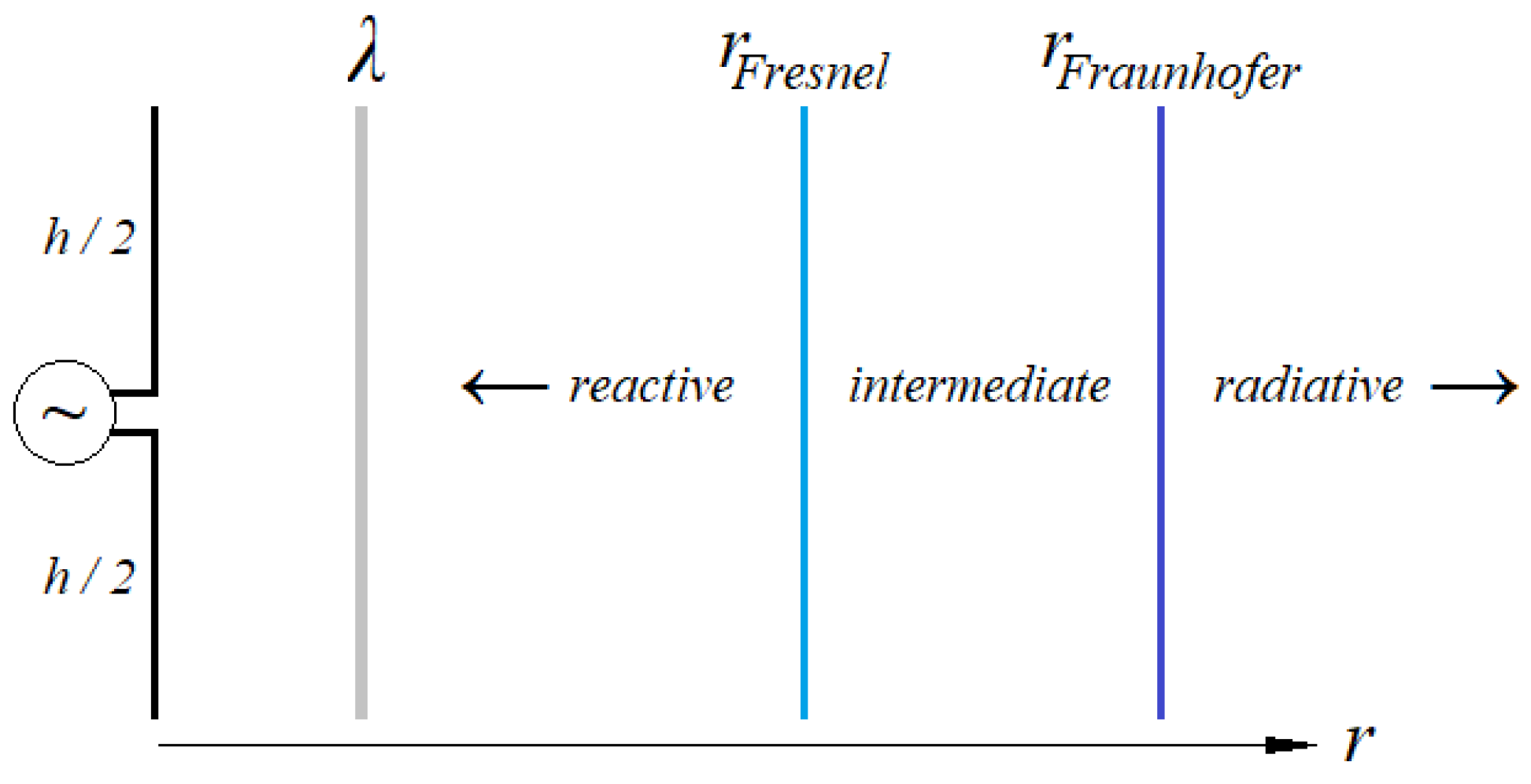

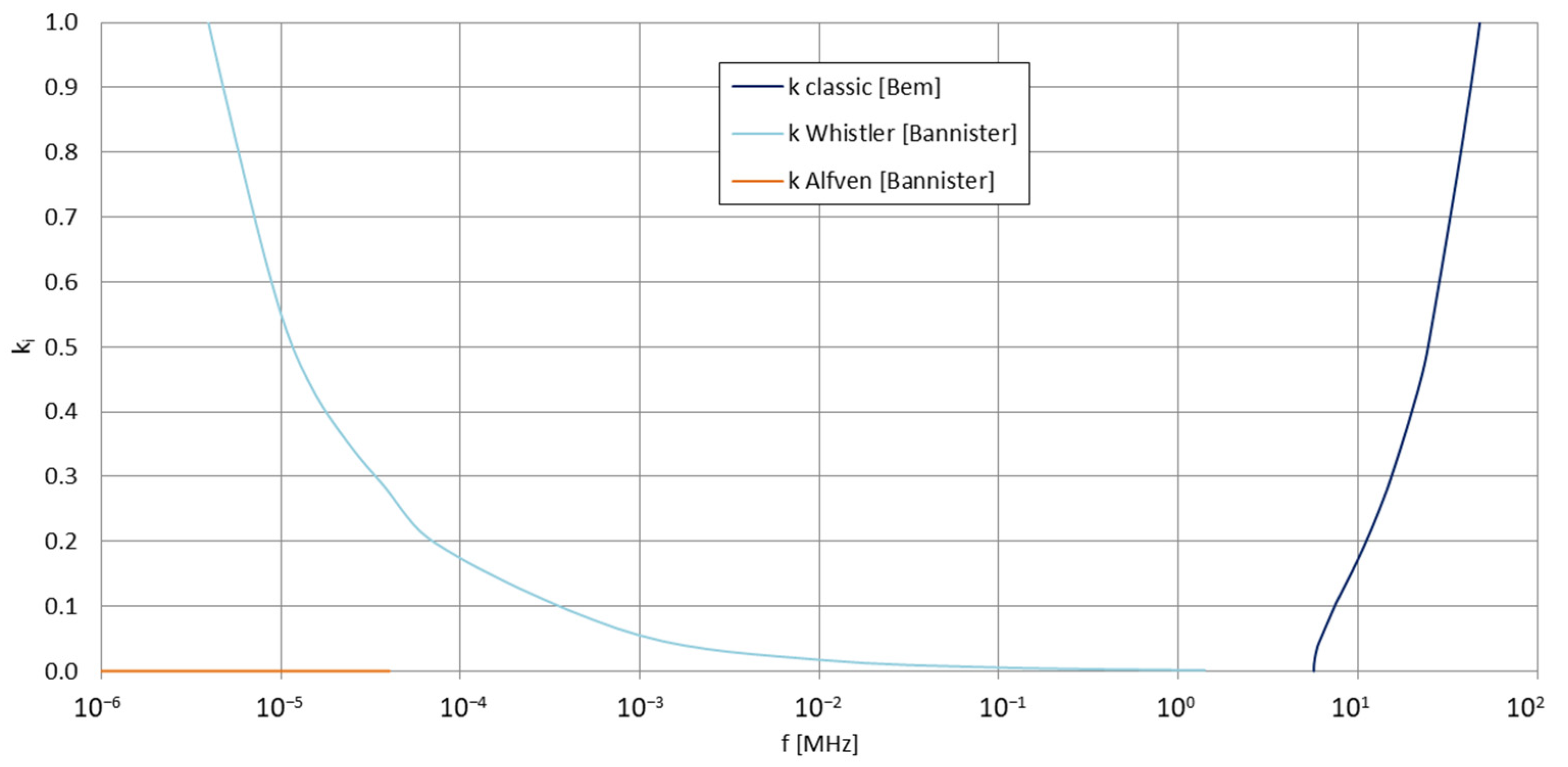
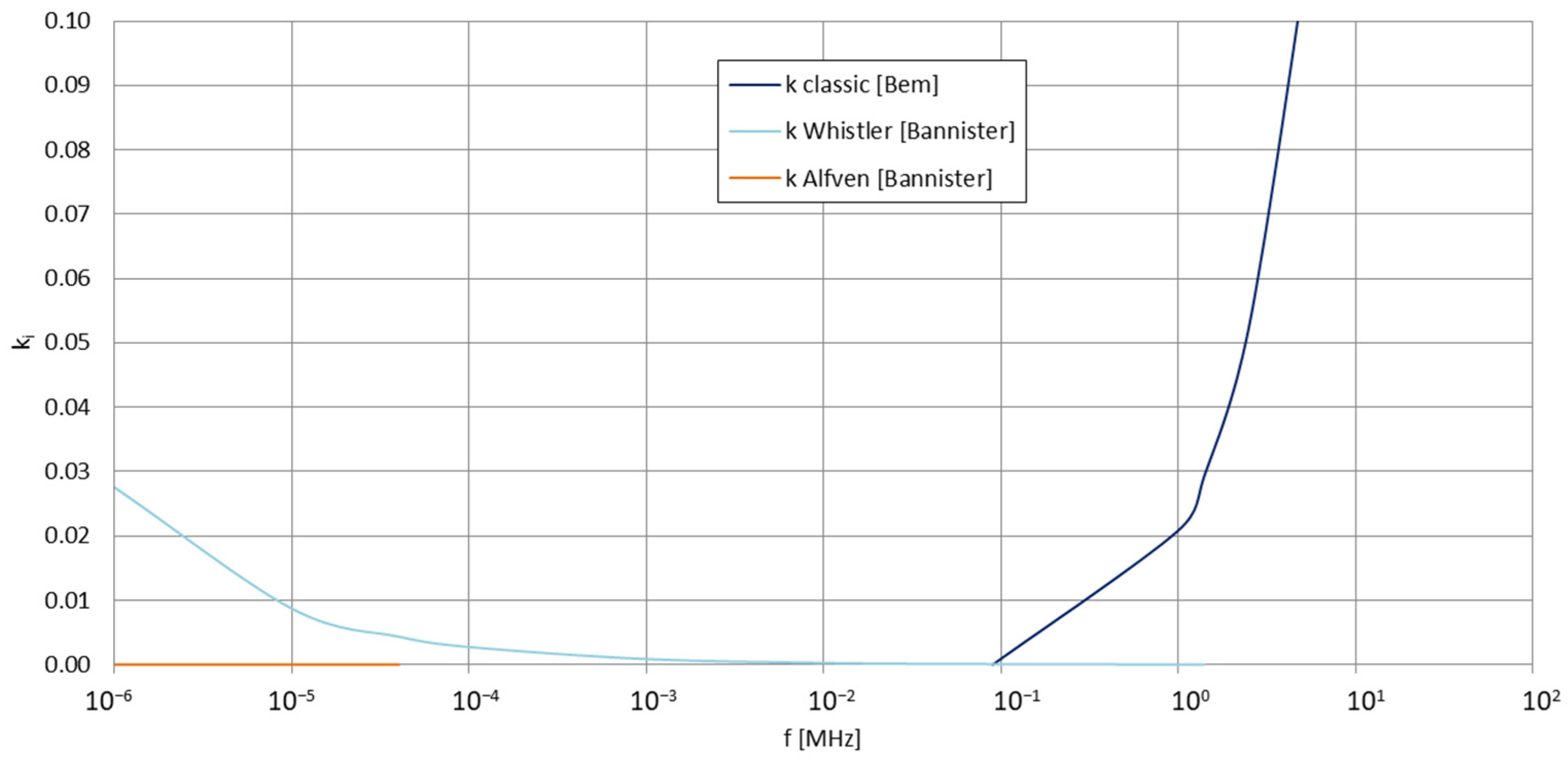
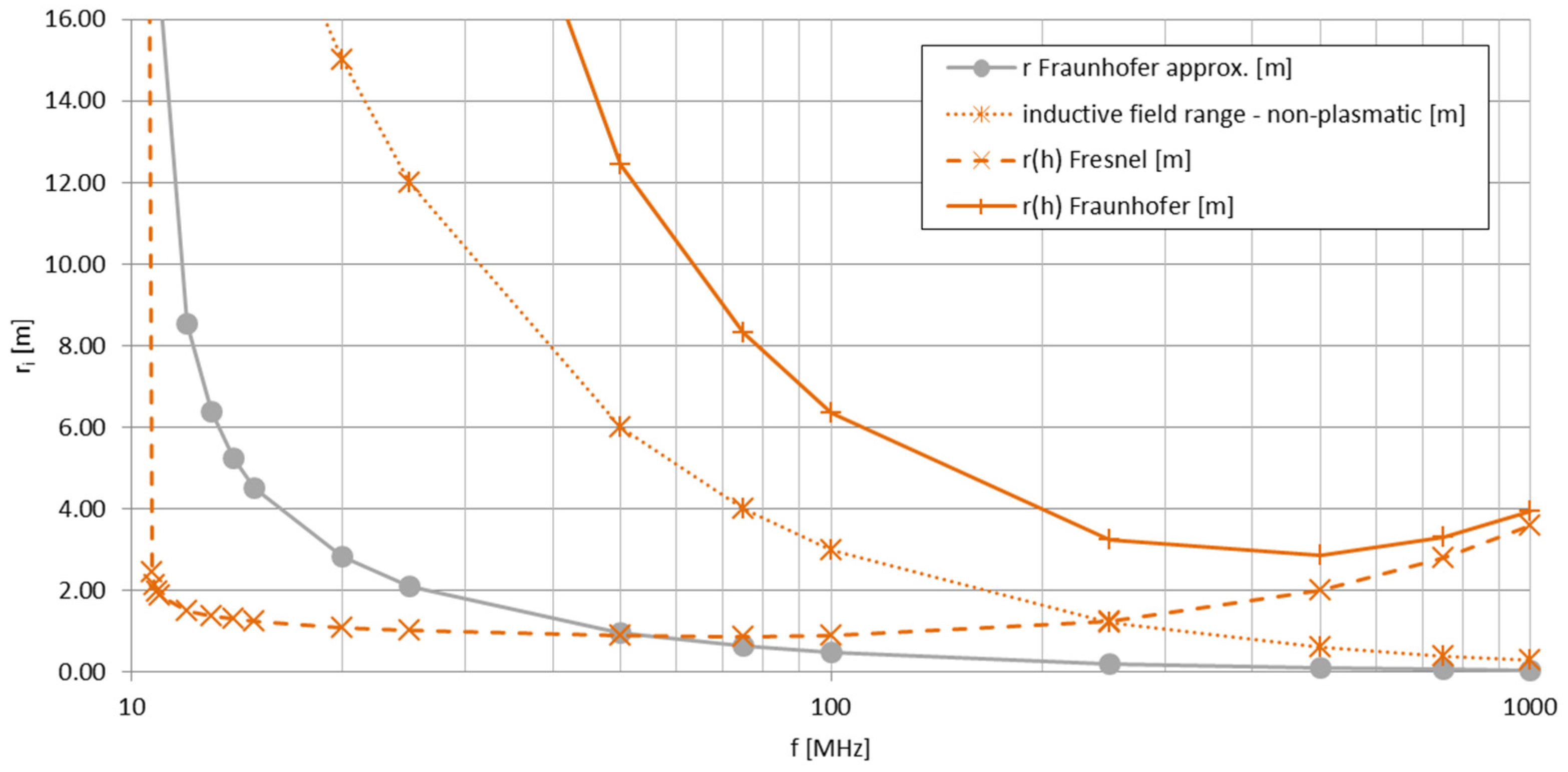

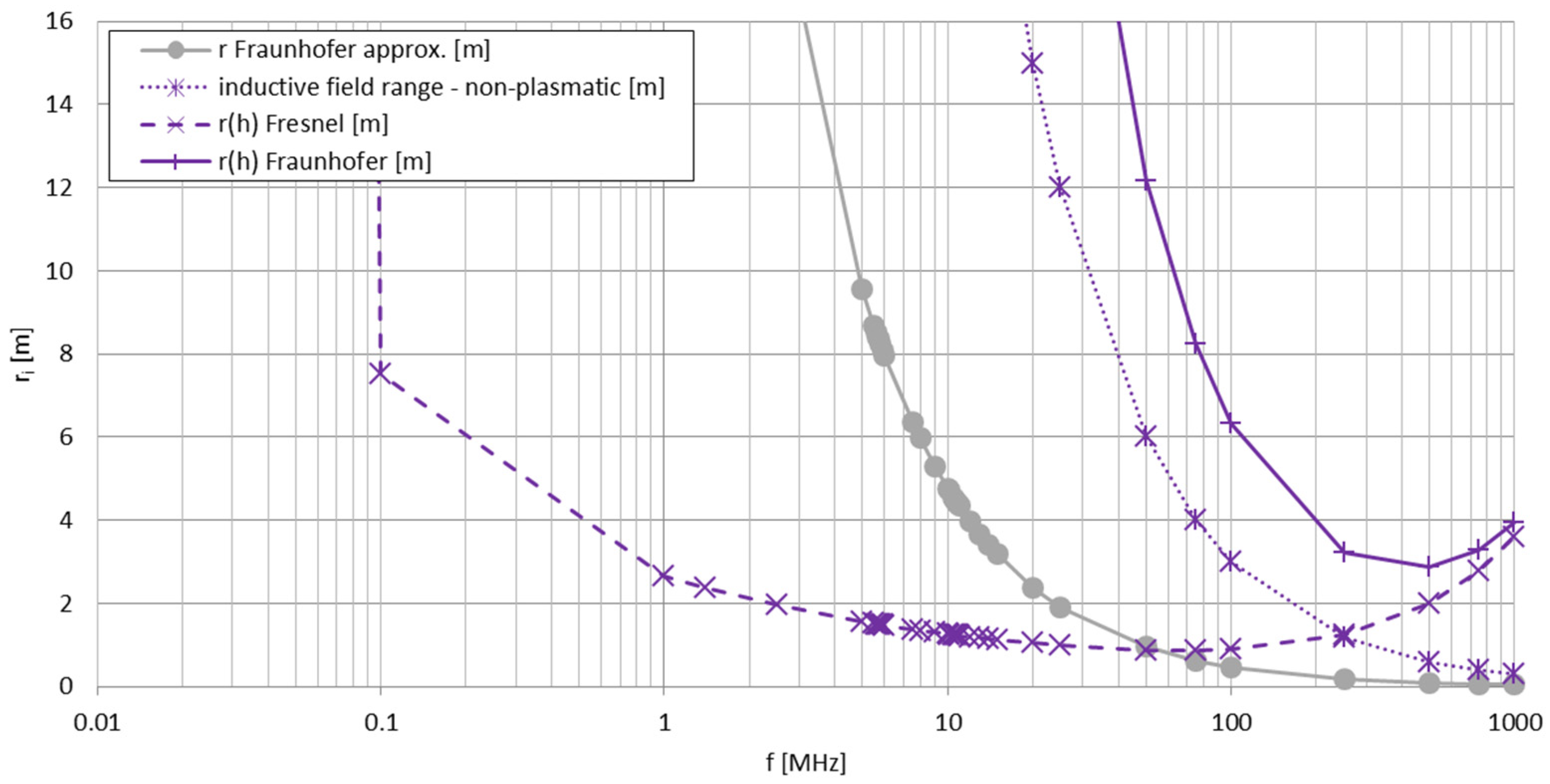
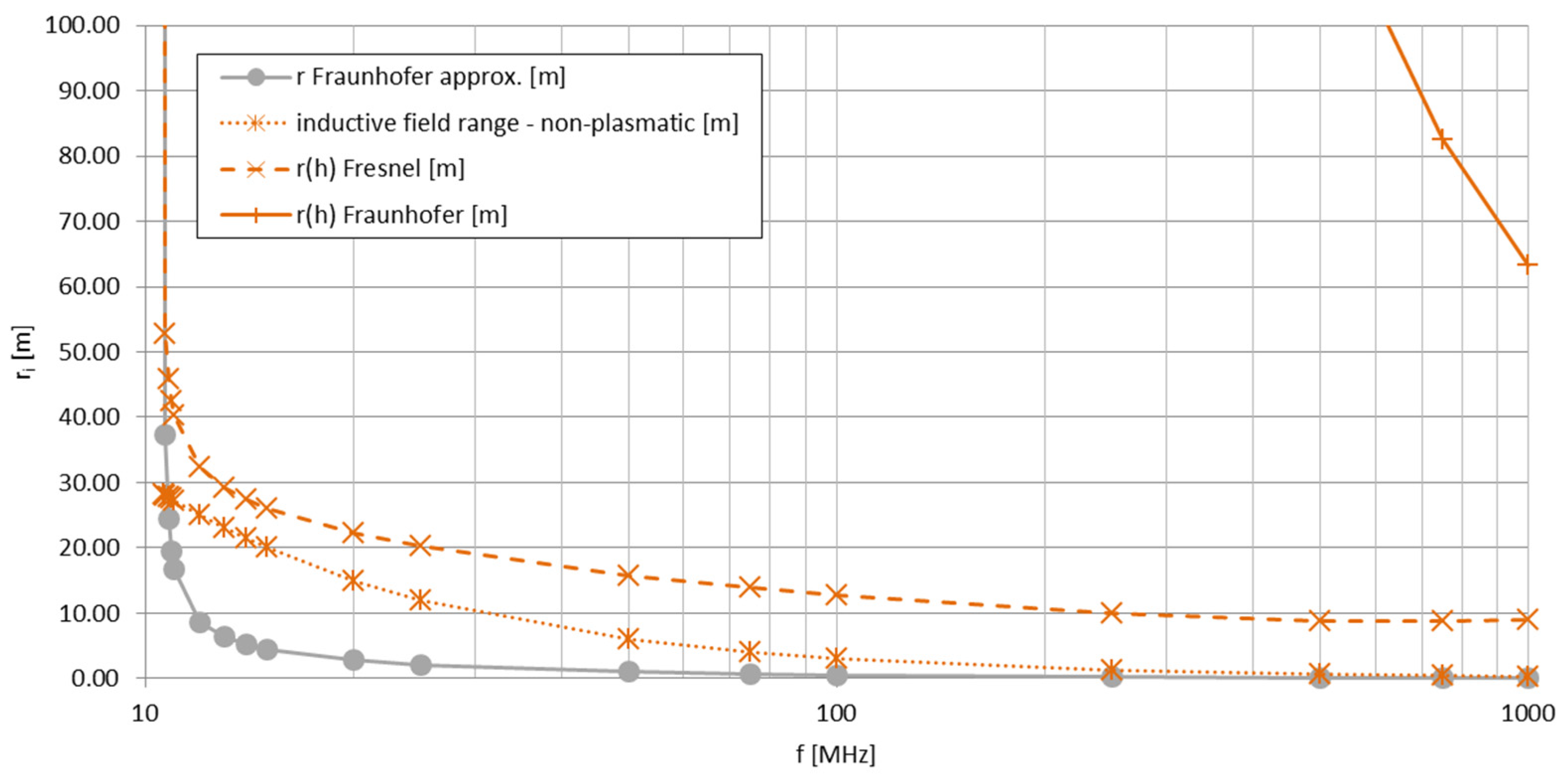

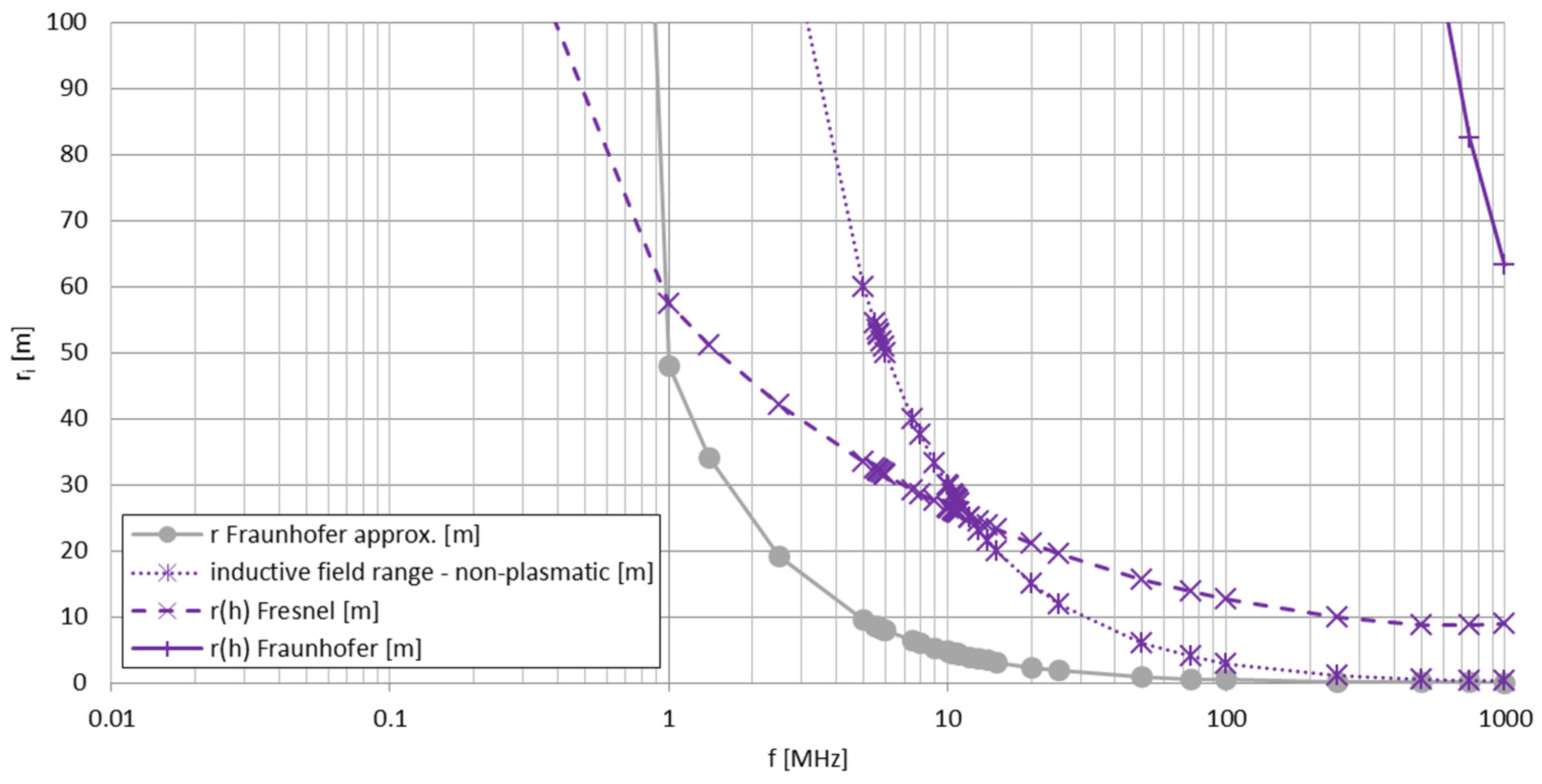


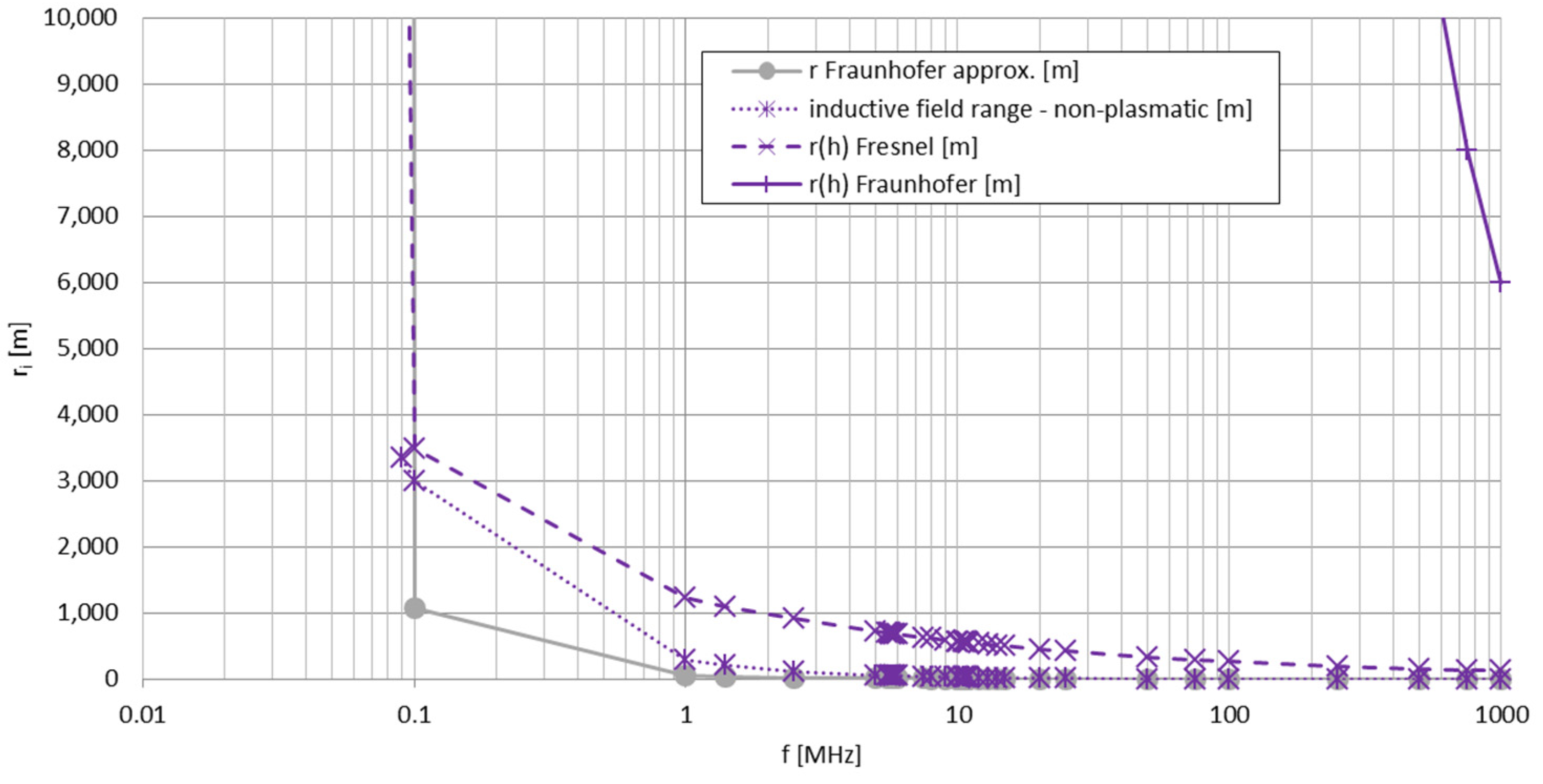
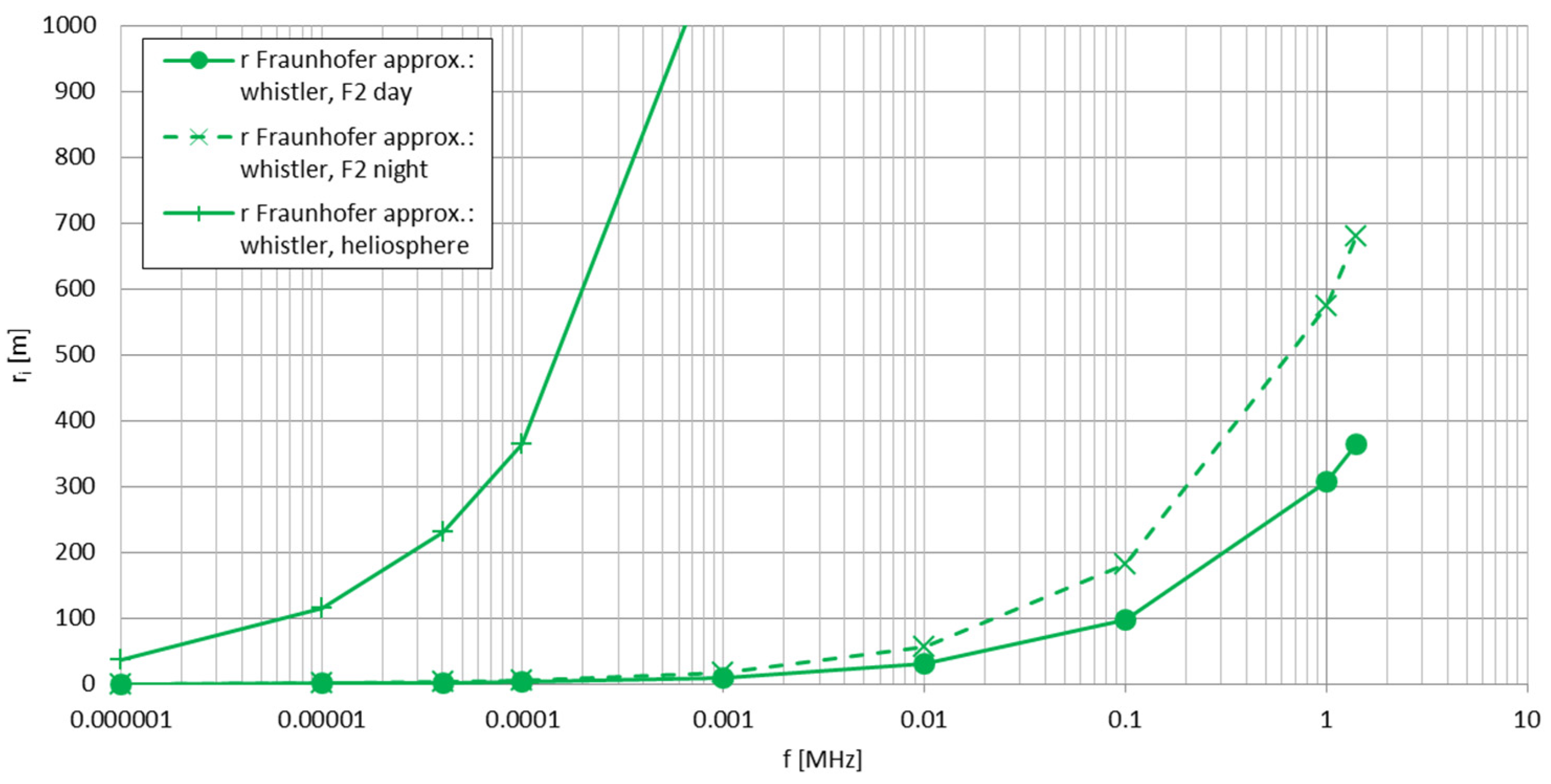



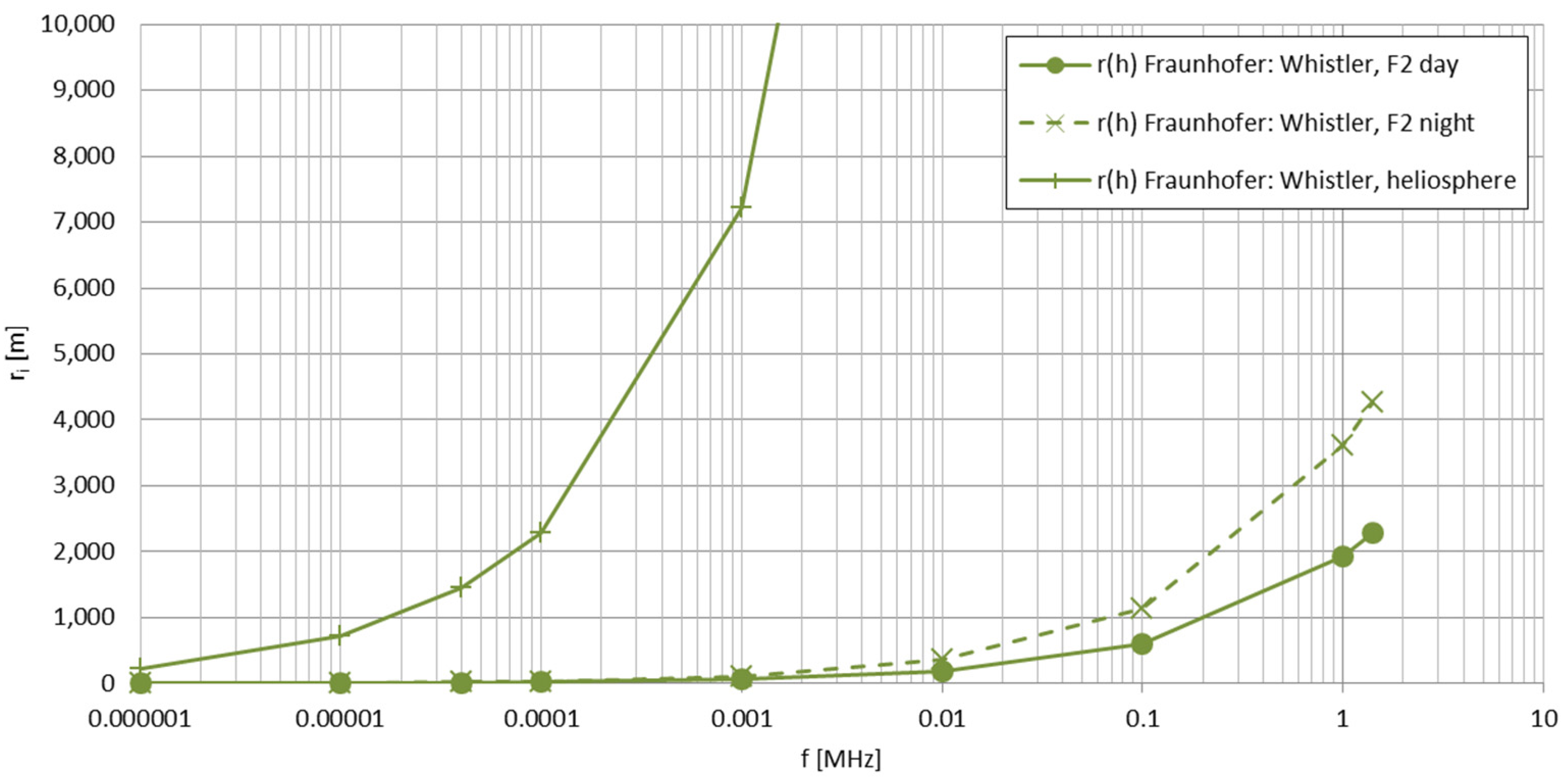
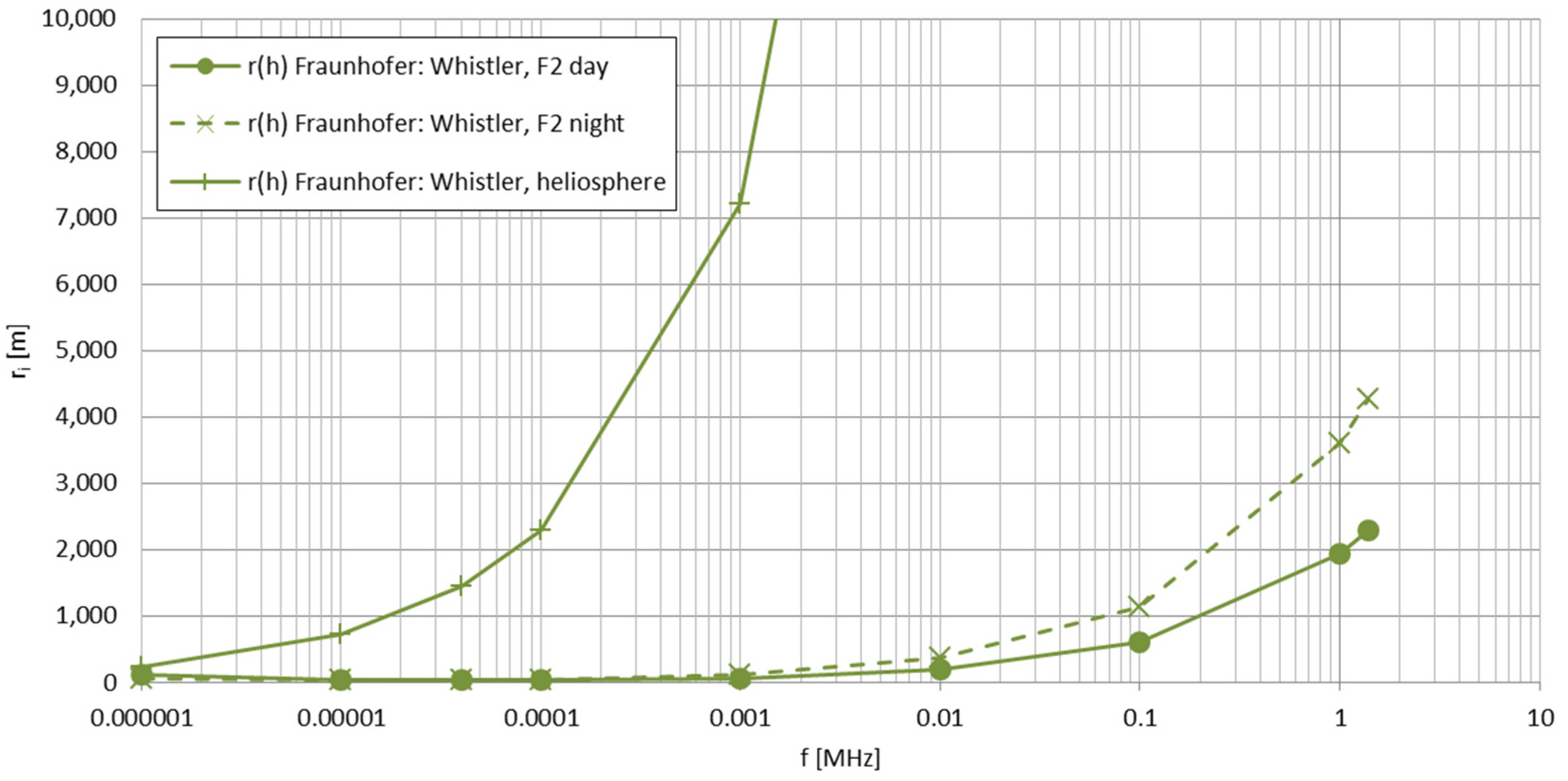
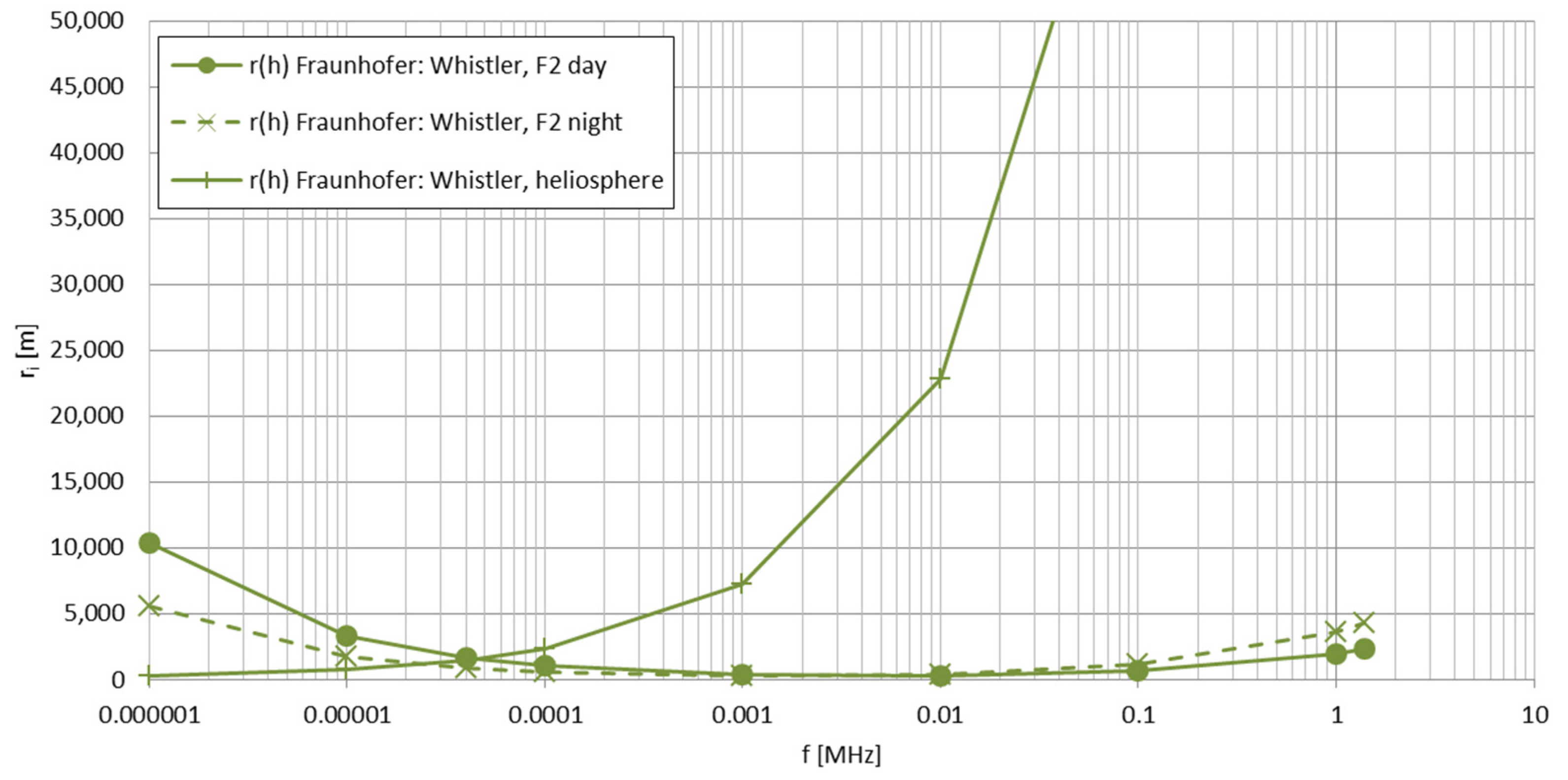
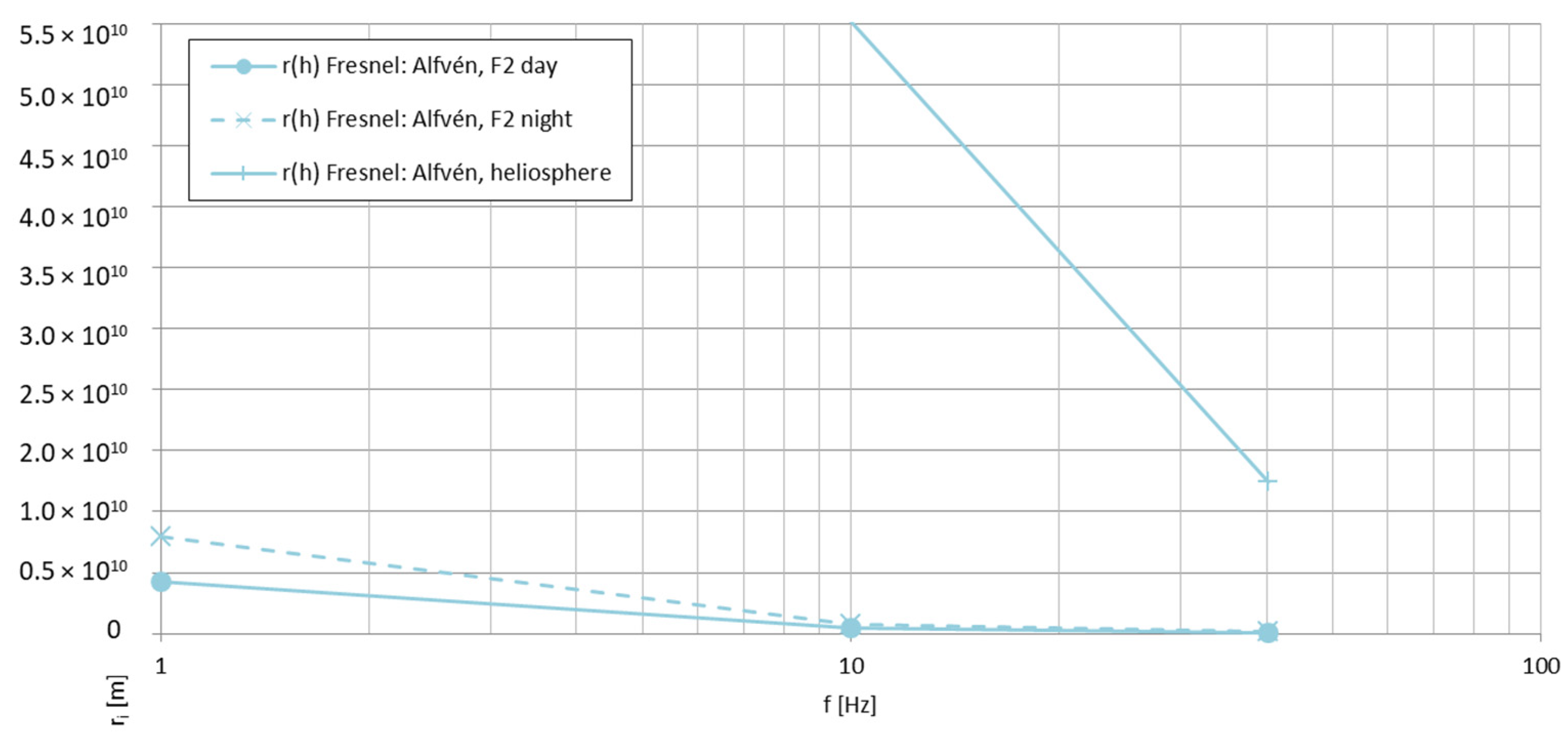
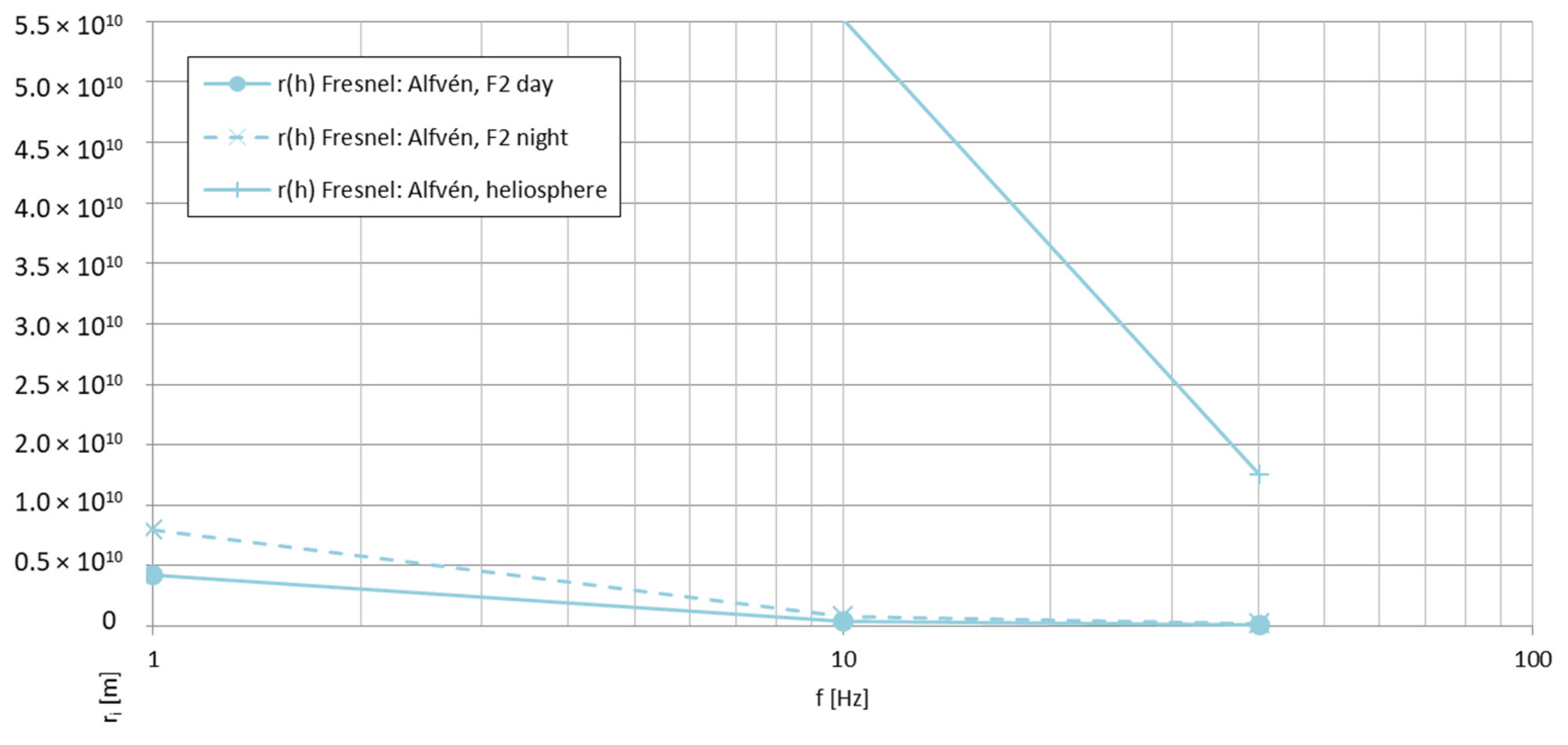
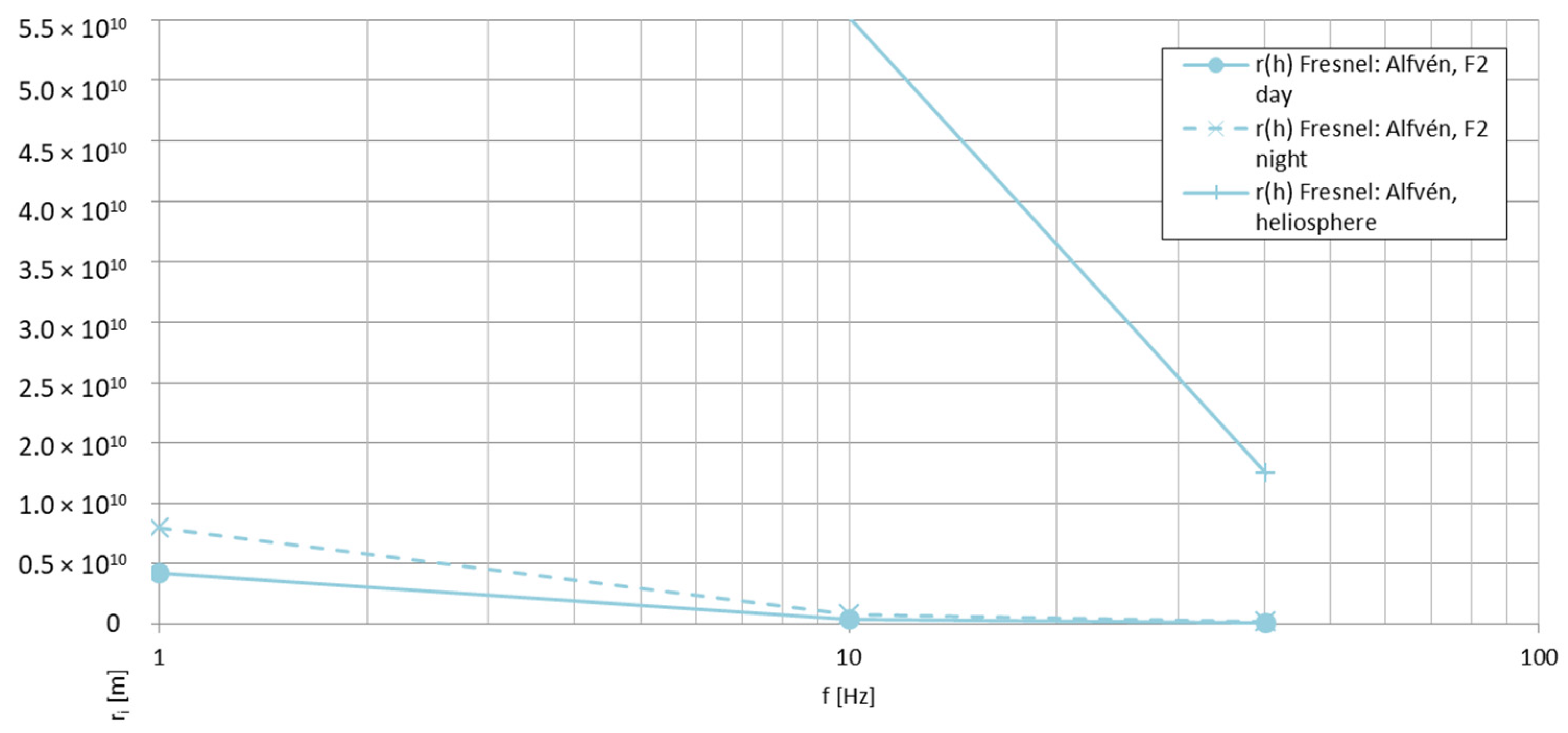
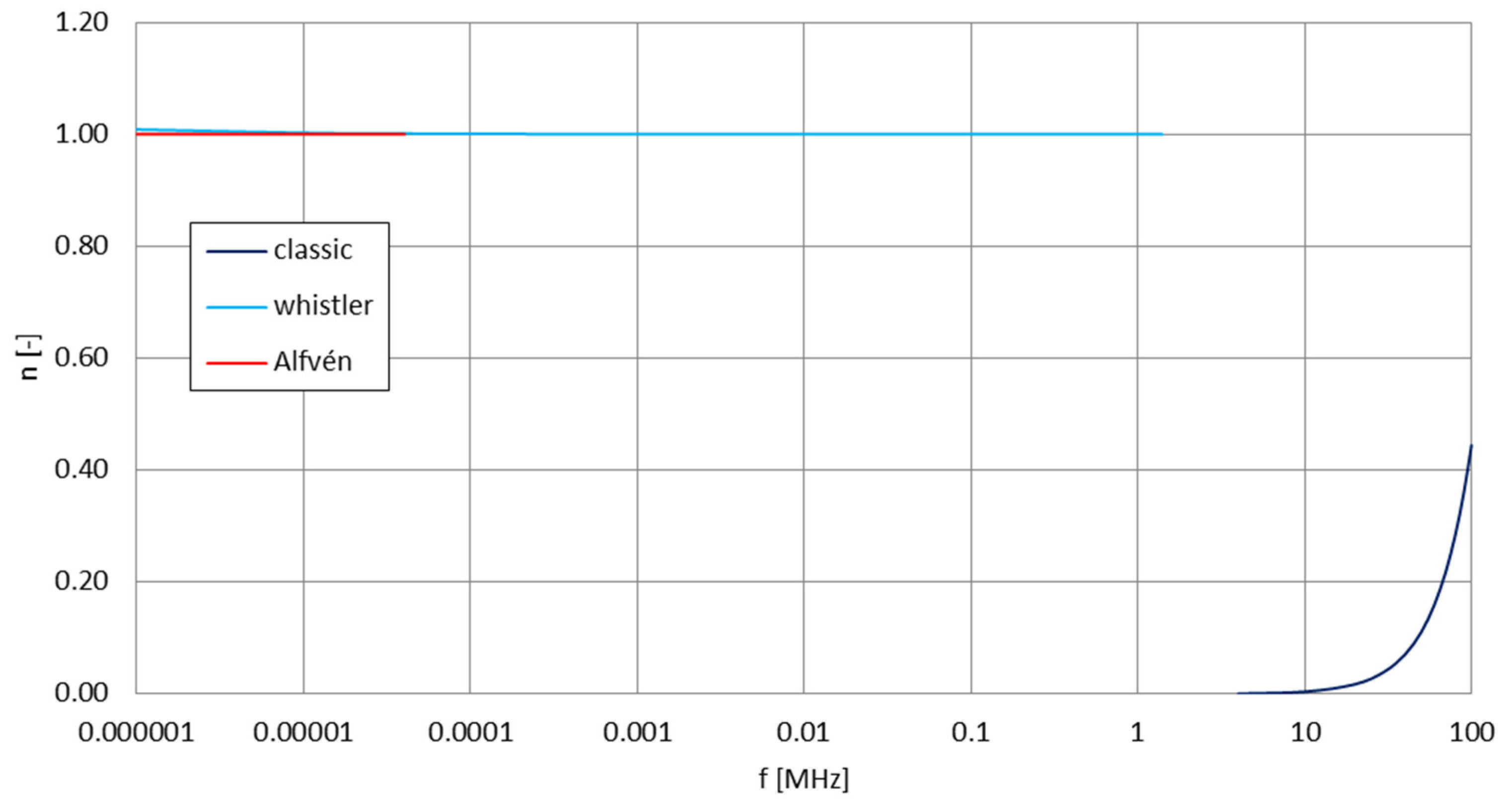



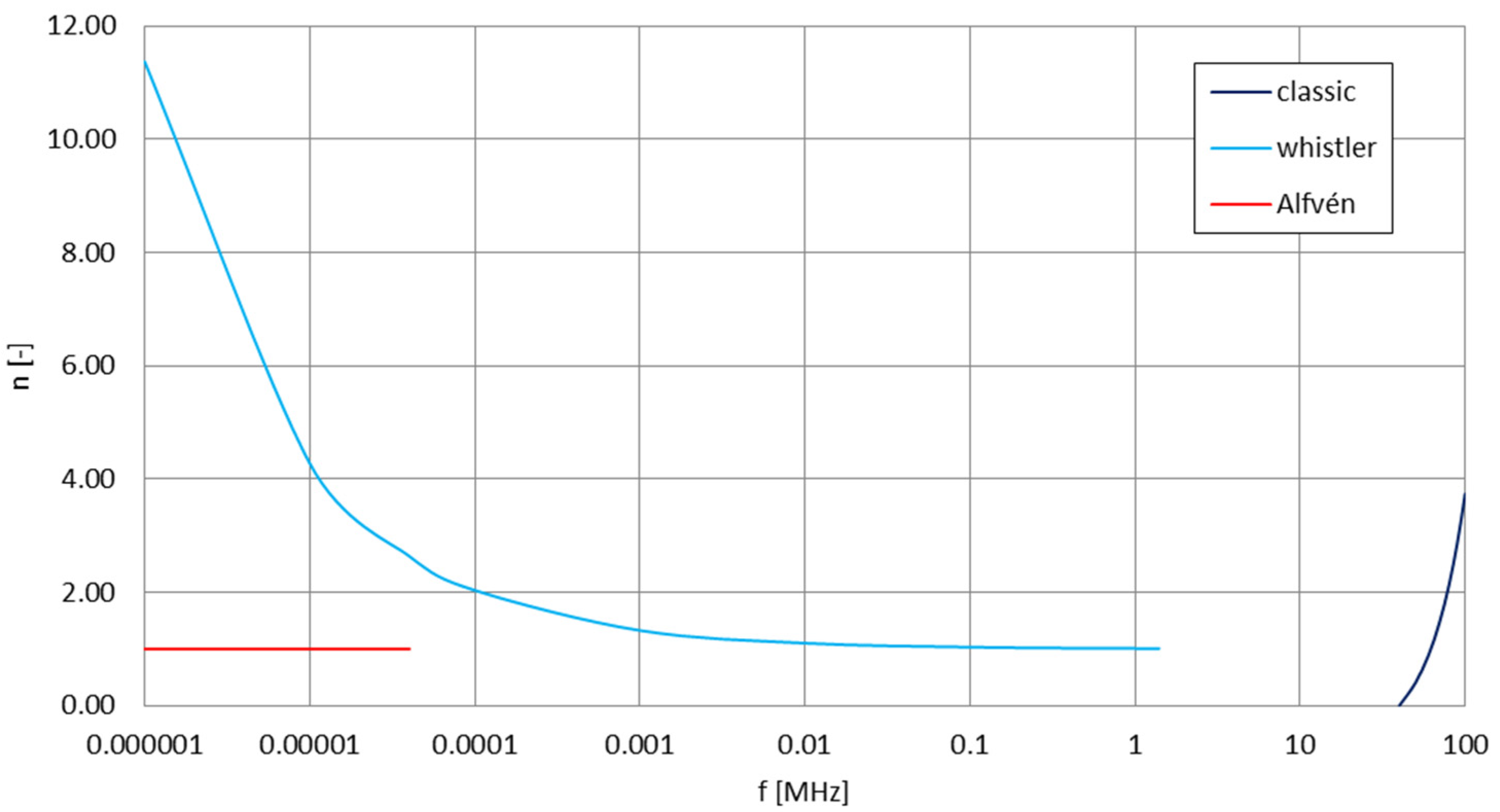
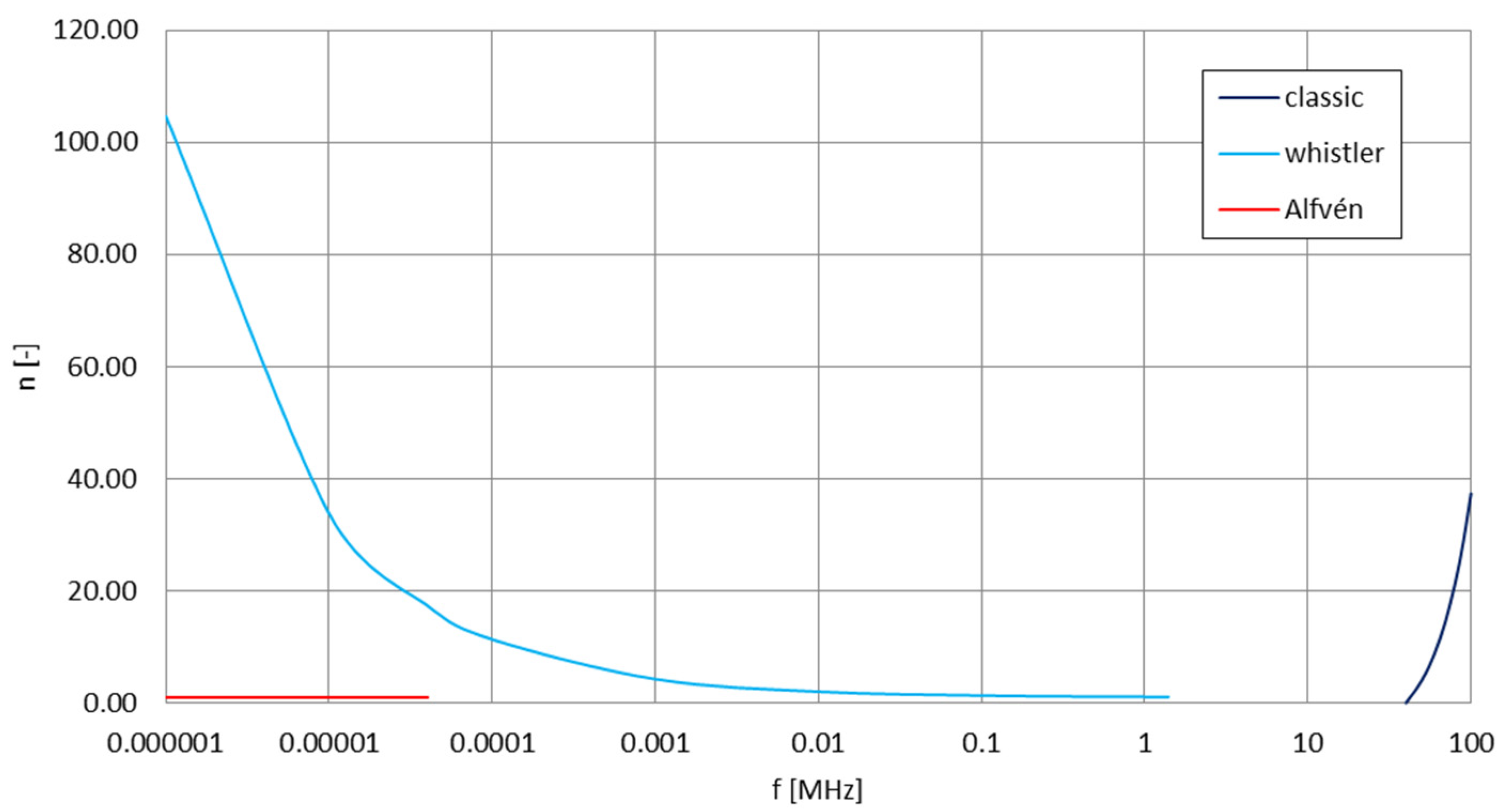
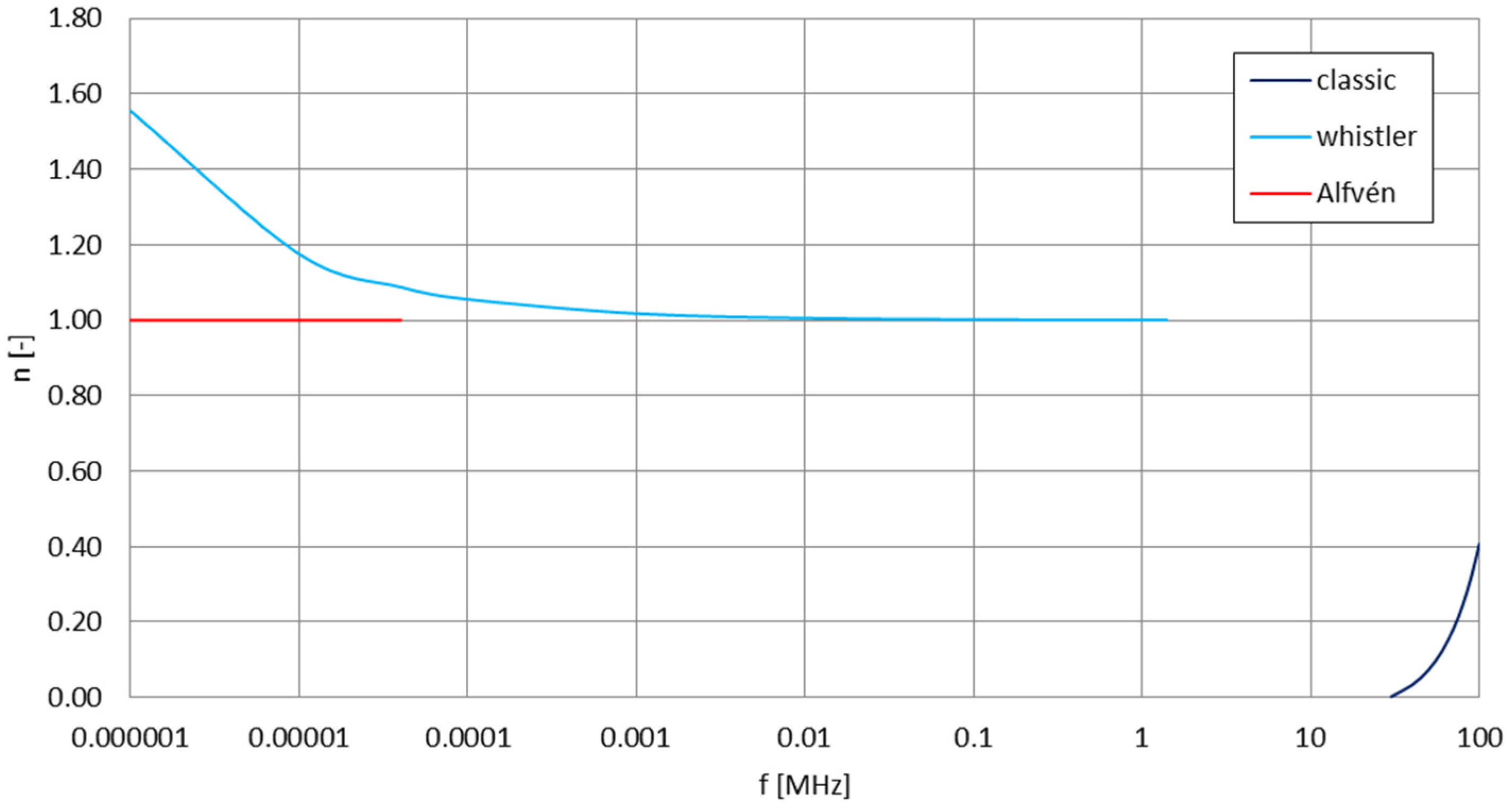
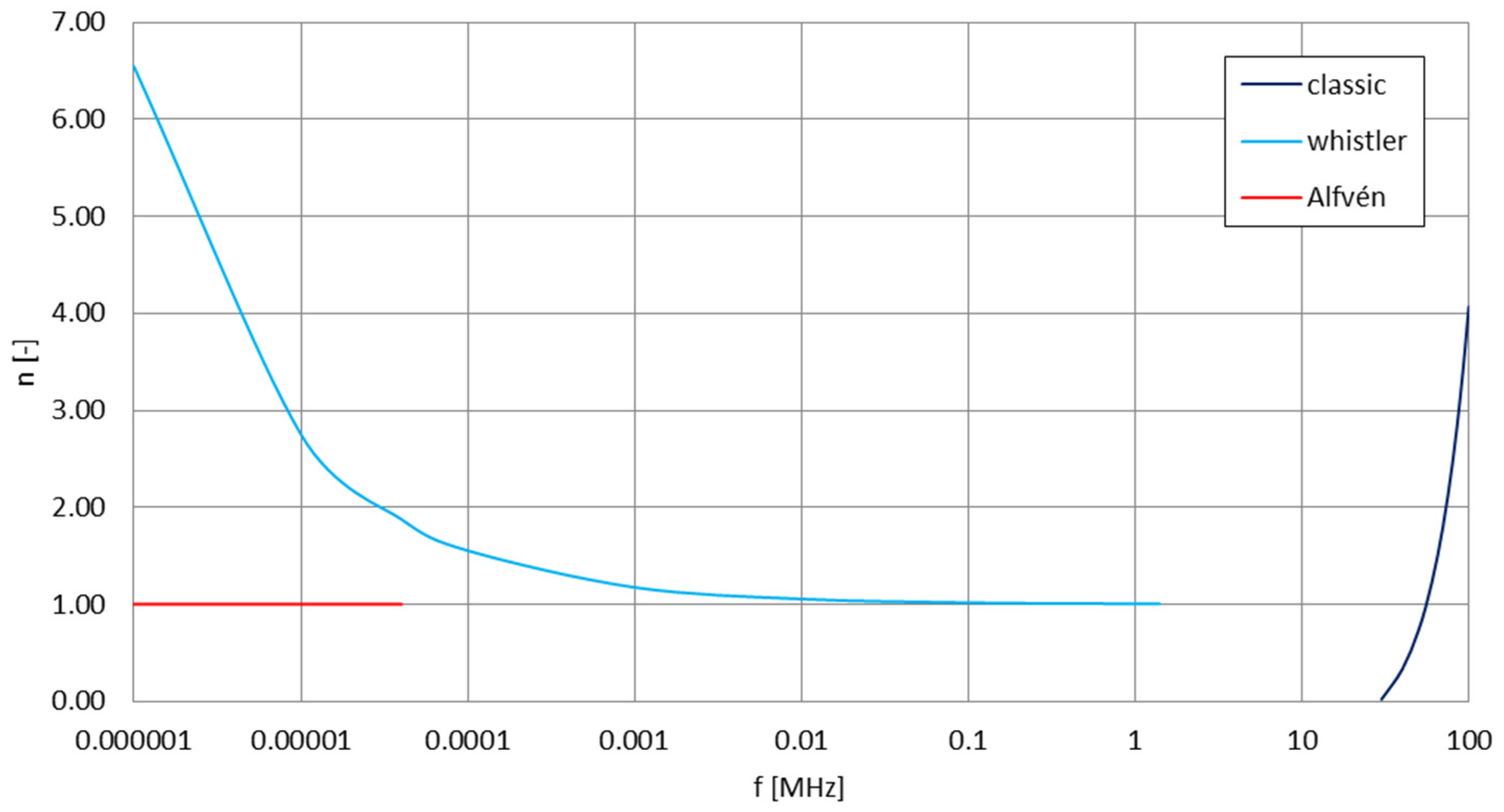
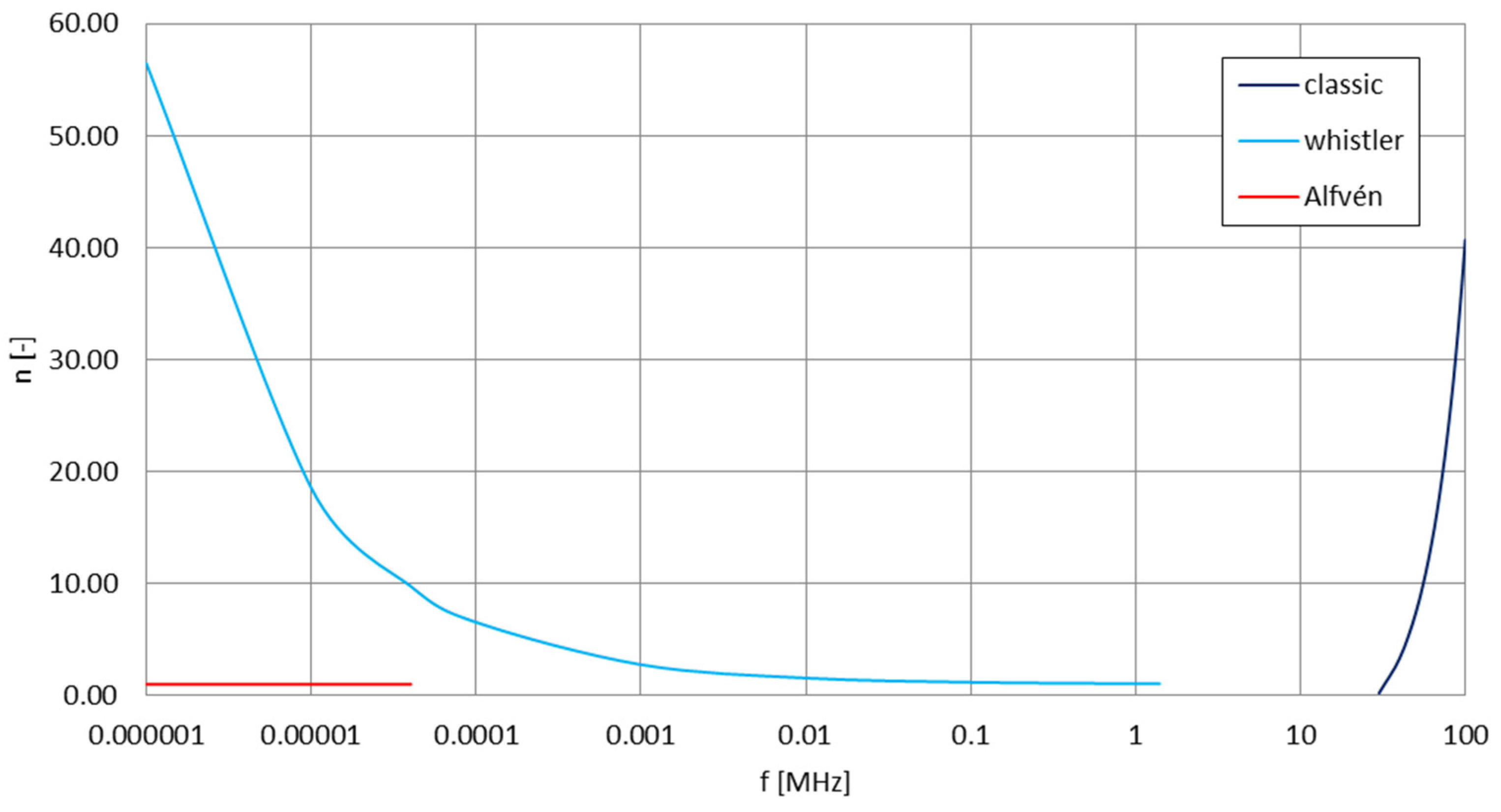

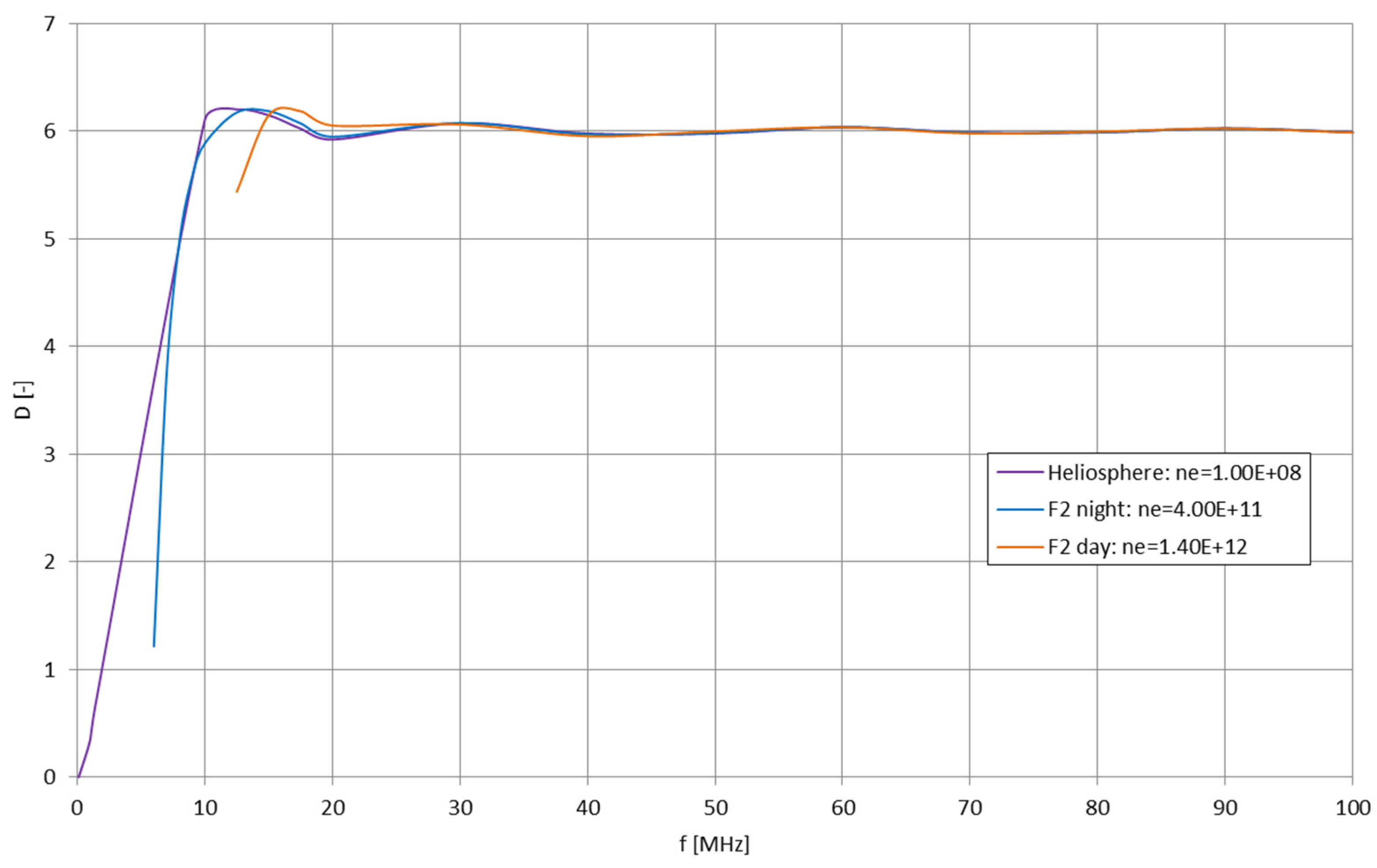
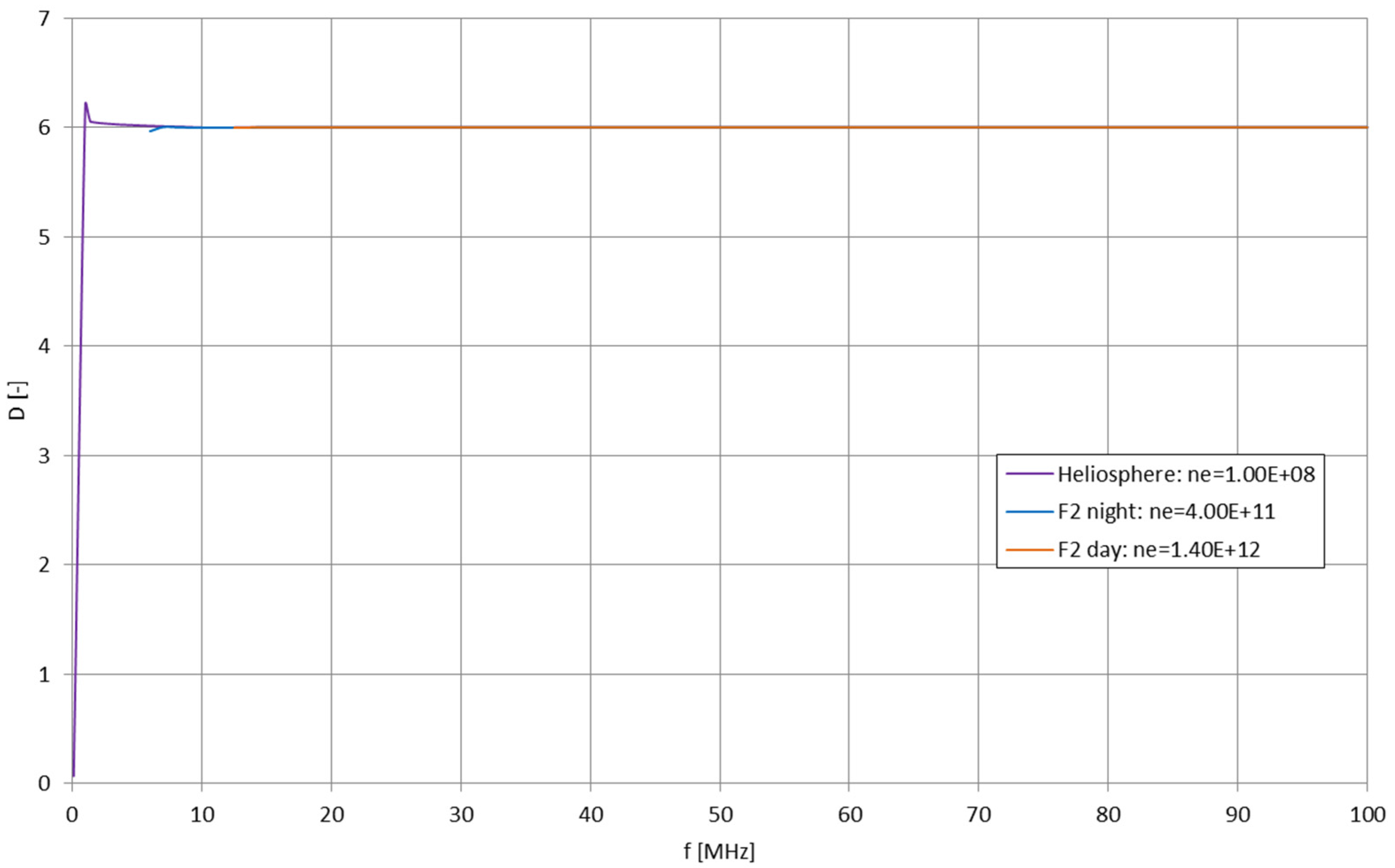
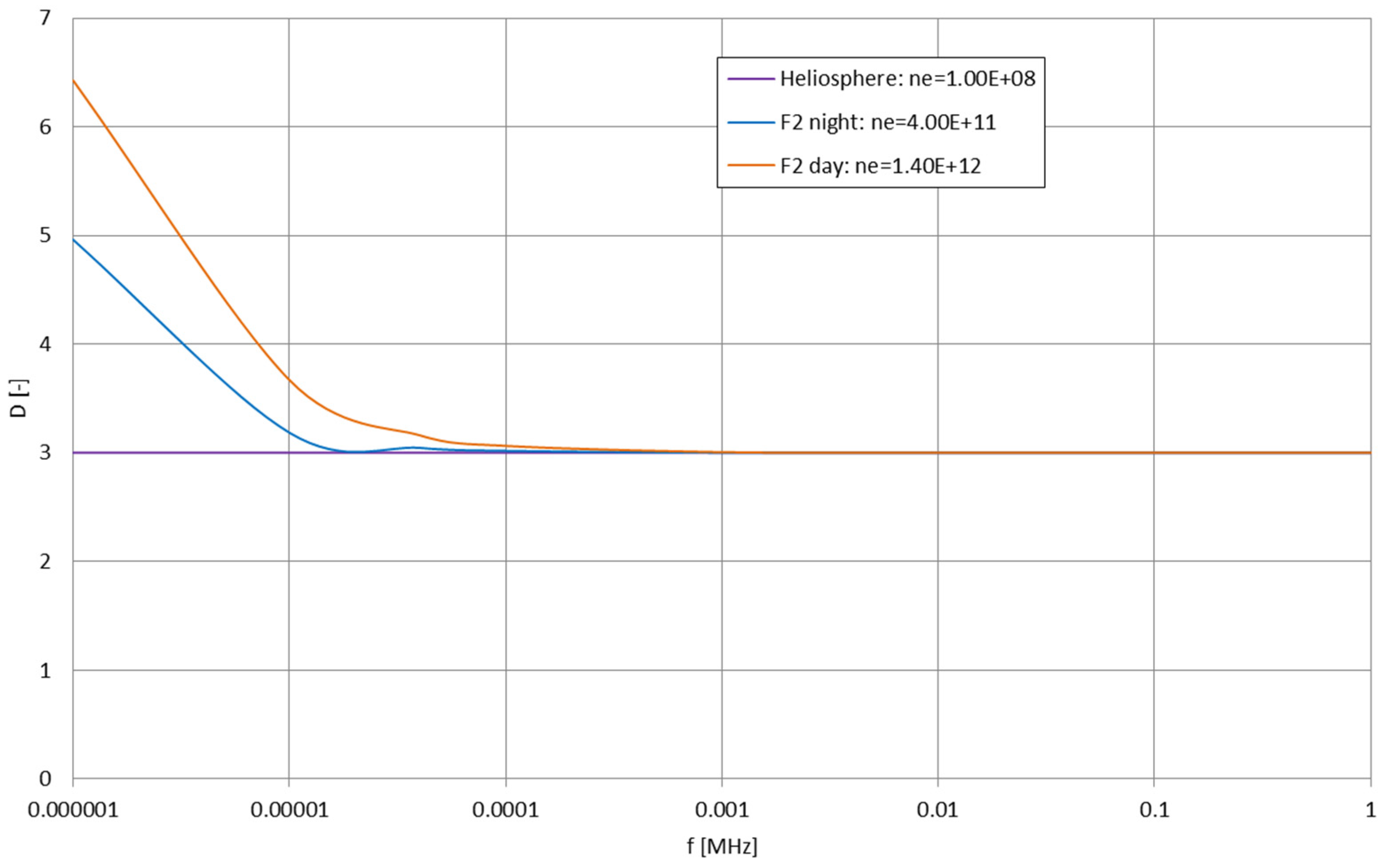
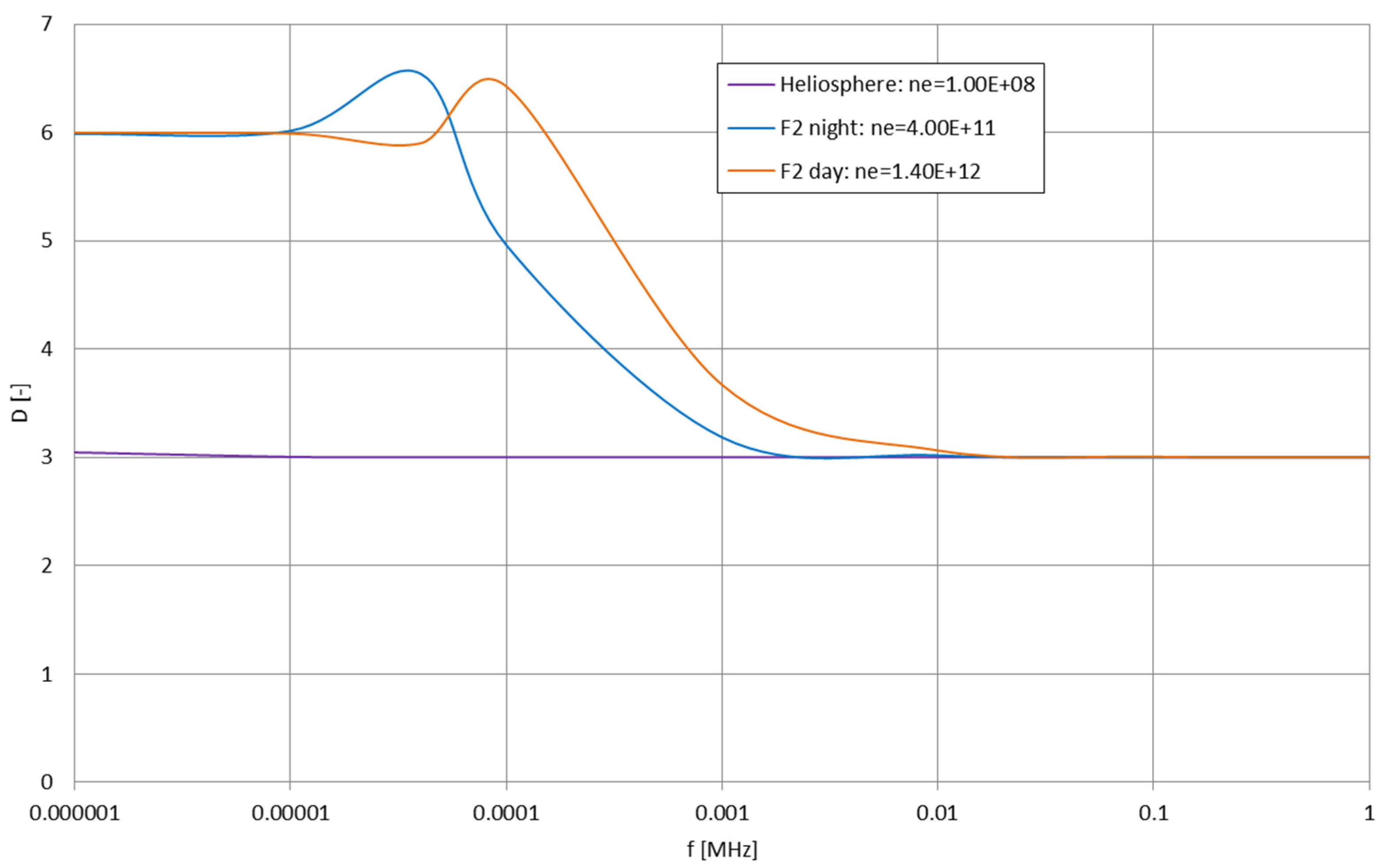
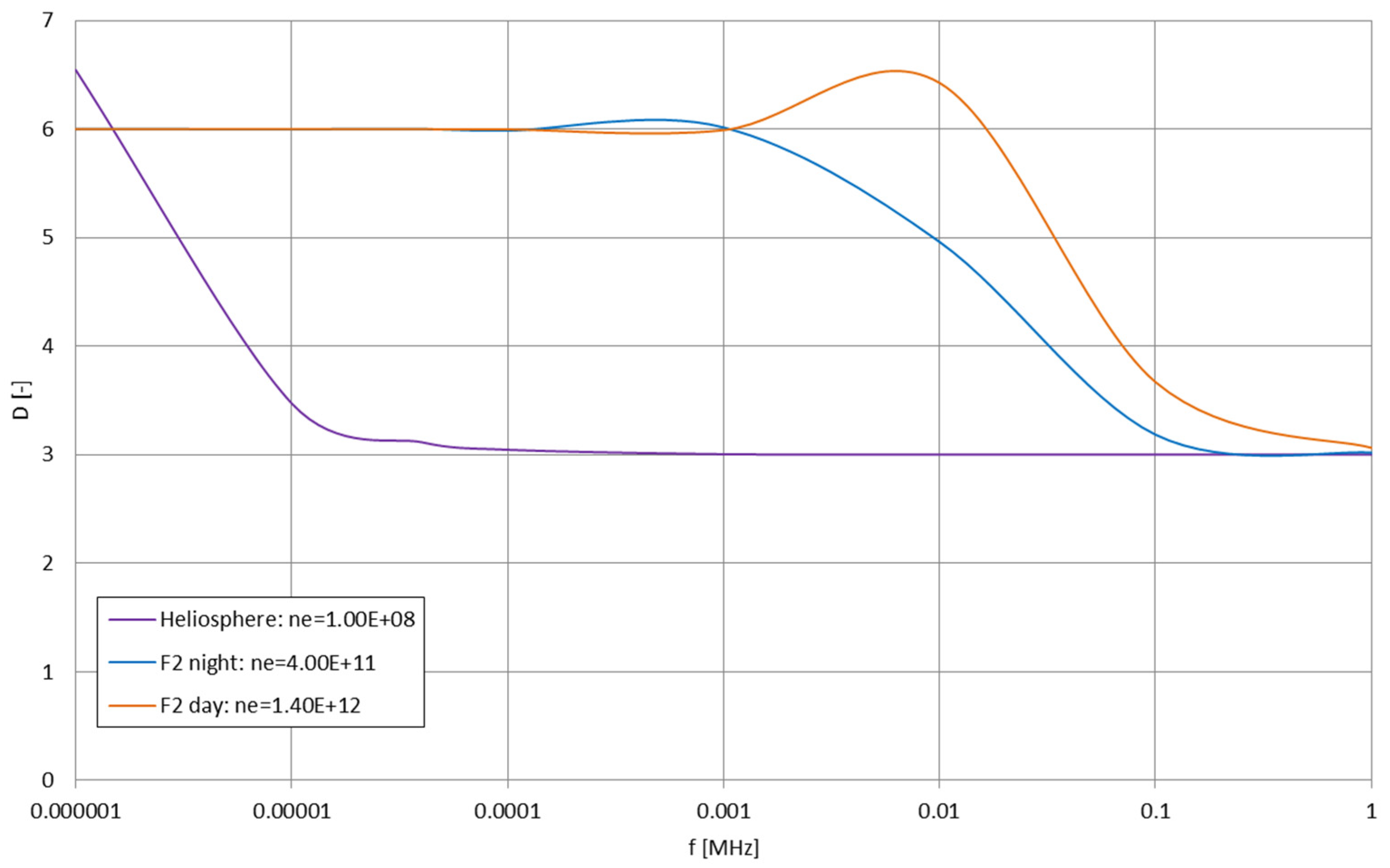
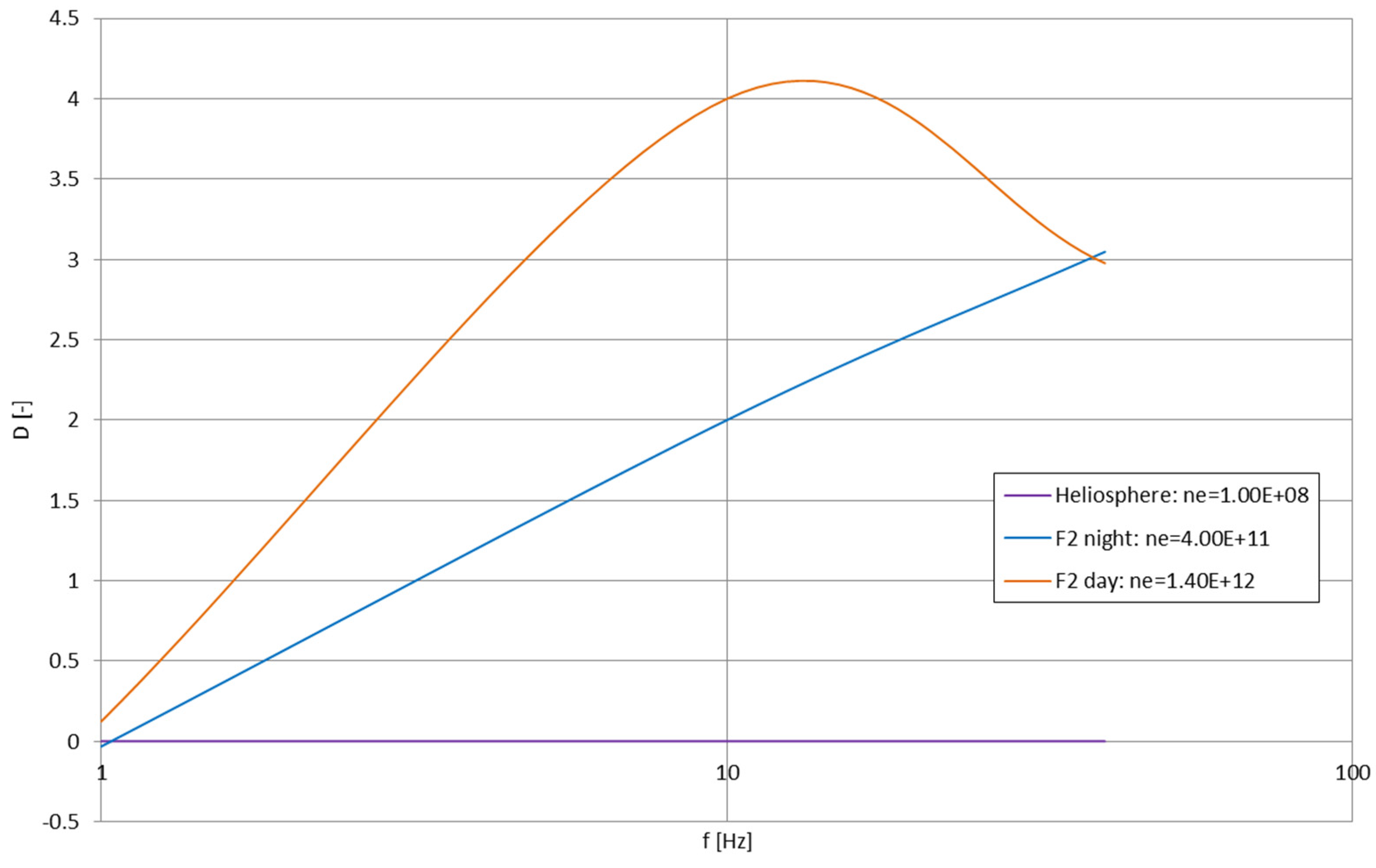
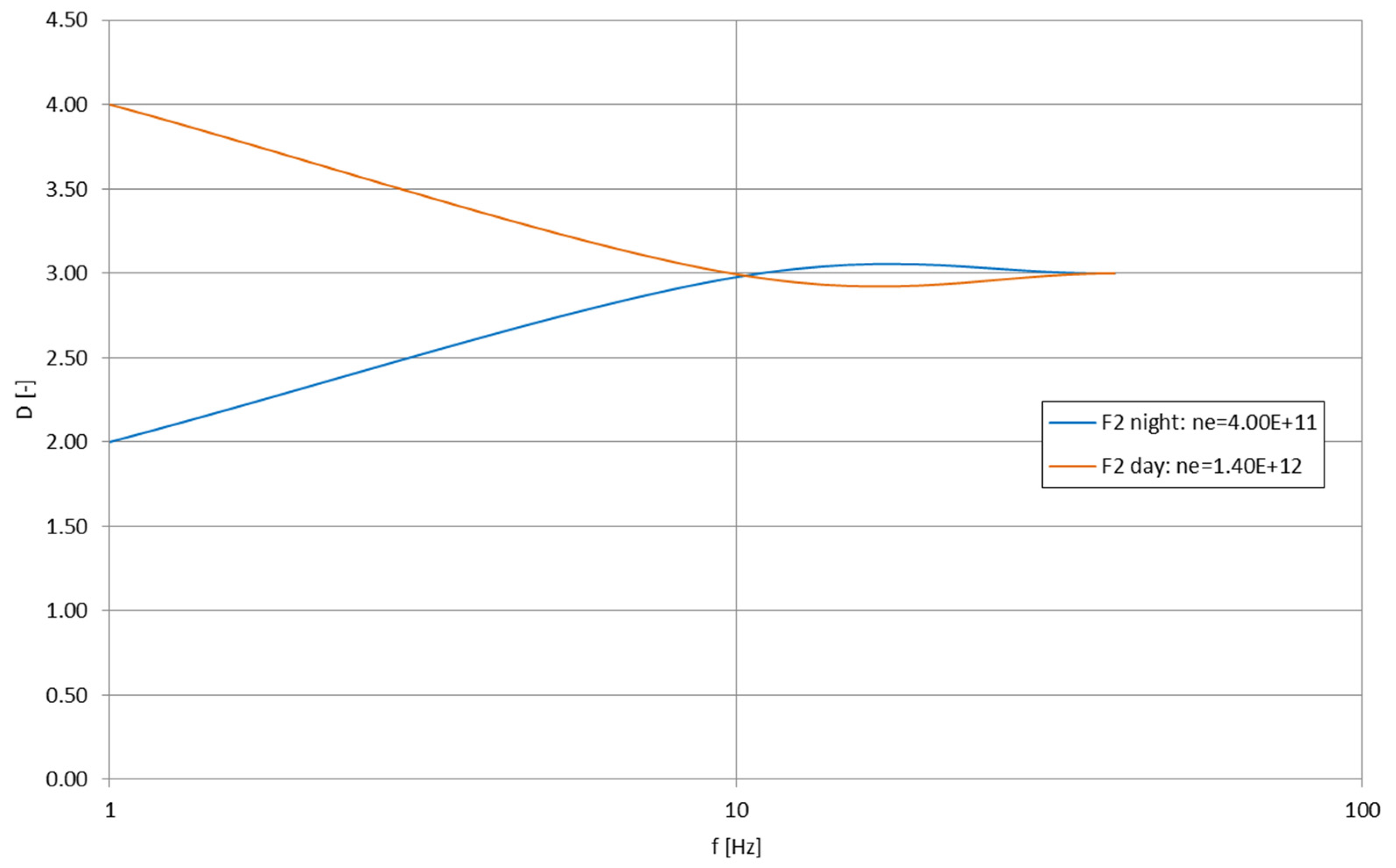
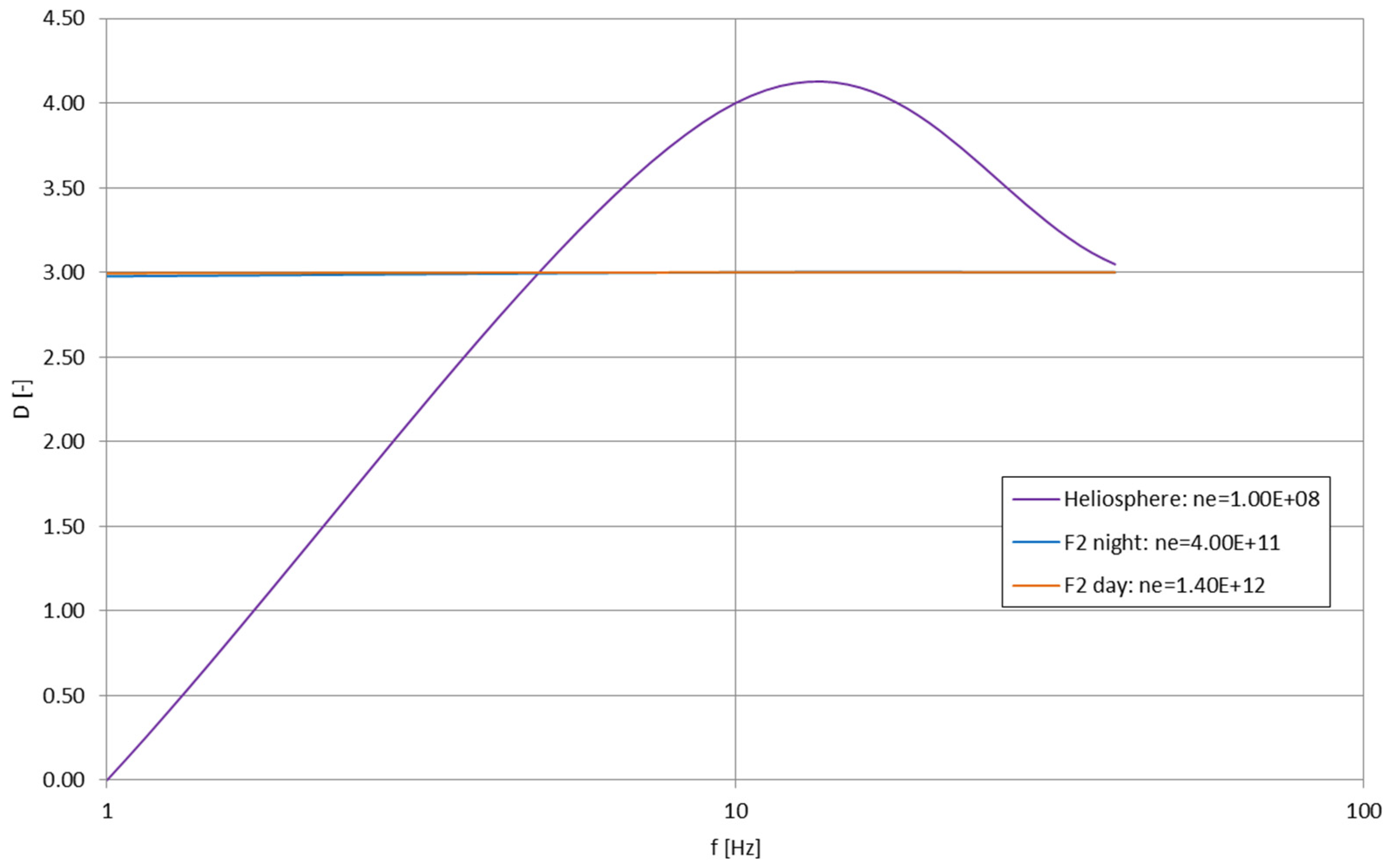

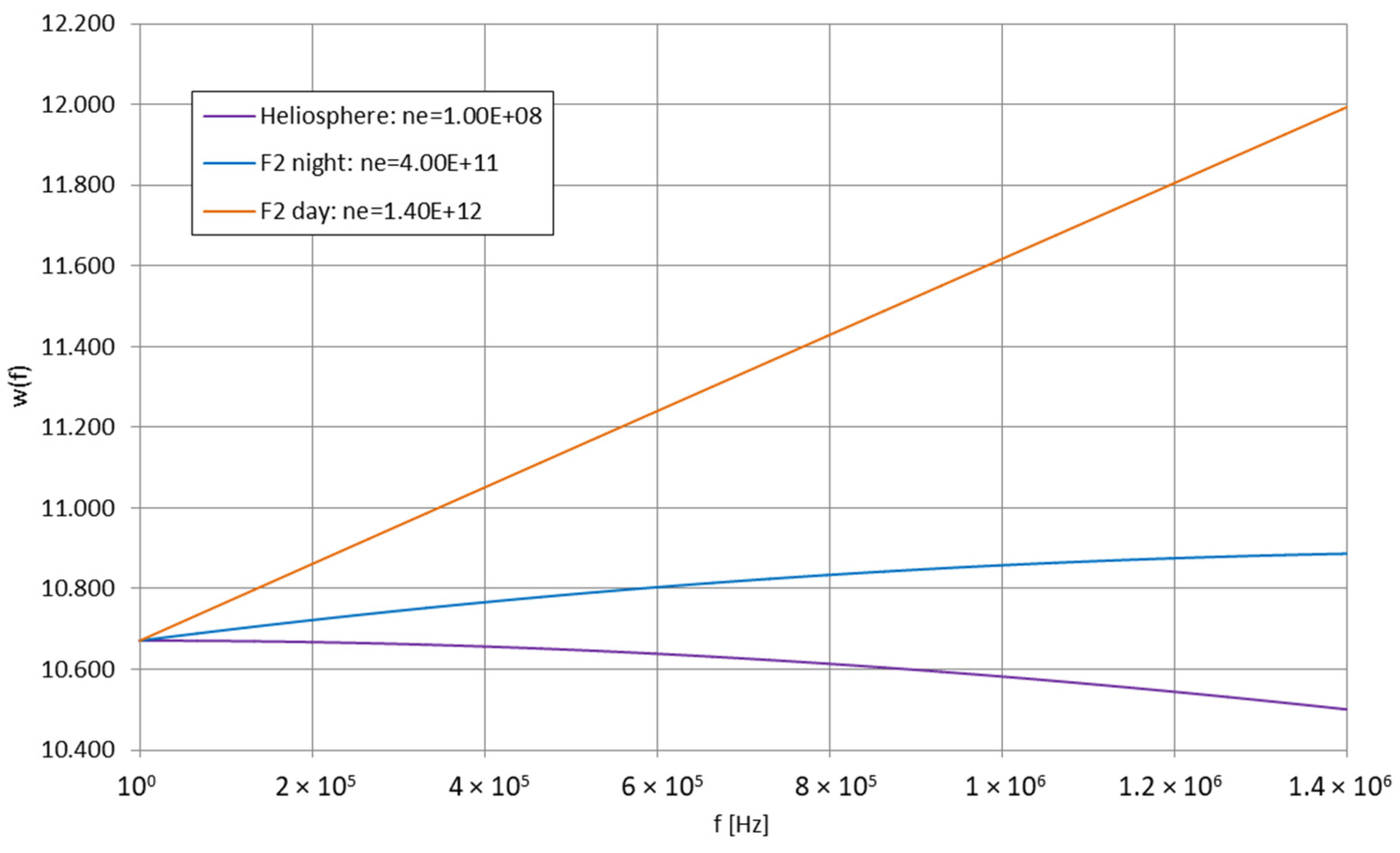
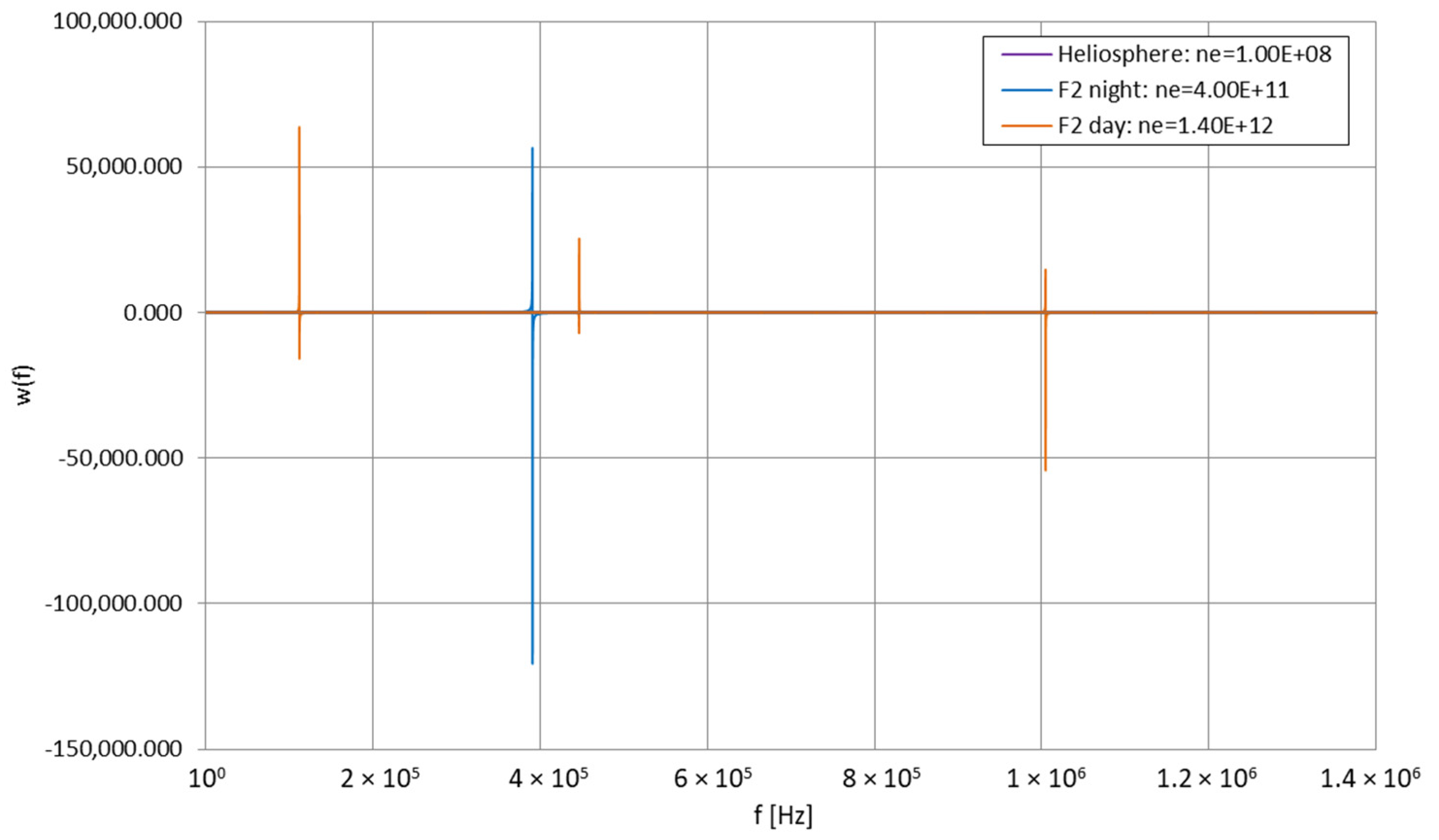
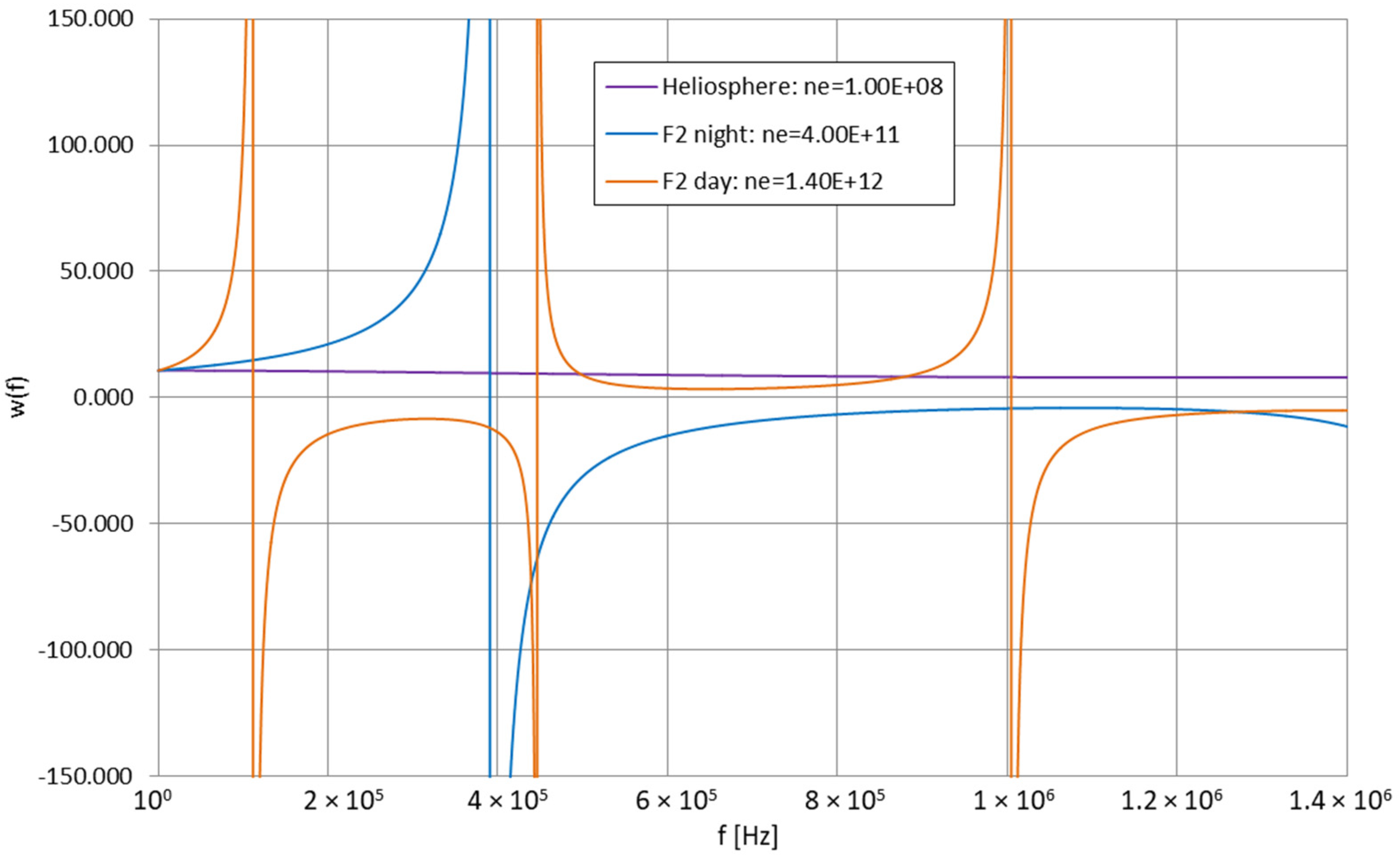
Disclaimer/Publisher’s Note: The statements, opinions and data contained in all publications are solely those of the individual author(s) and contributor(s) and not of MDPI and/or the editor(s). MDPI and/or the editor(s) disclaim responsibility for any injury to people or property resulting from any ideas, methods, instructions or products referred to in the content. |
© 2024 by the author. Licensee MDPI, Basel, Switzerland. This article is an open access article distributed under the terms and conditions of the Creative Commons Attribution (CC BY) license (https://creativecommons.org/licenses/by/4.0/).
Share and Cite
Miś, T.A. Evolution of Antenna Radiation Parameters for Air-to-Plasma Transition. Electronics 2024, 13, 3040. https://doi.org/10.3390/electronics13153040
Miś TA. Evolution of Antenna Radiation Parameters for Air-to-Plasma Transition. Electronics. 2024; 13(15):3040. https://doi.org/10.3390/electronics13153040
Chicago/Turabian StyleMiś, Tomasz Aleksander. 2024. "Evolution of Antenna Radiation Parameters for Air-to-Plasma Transition" Electronics 13, no. 15: 3040. https://doi.org/10.3390/electronics13153040
APA StyleMiś, T. A. (2024). Evolution of Antenna Radiation Parameters for Air-to-Plasma Transition. Electronics, 13(15), 3040. https://doi.org/10.3390/electronics13153040






